
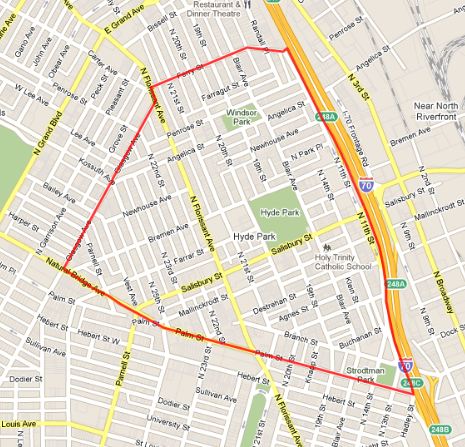 Hyde Park is a north St. Louis neighborhood roughly bound by Ferry Street to the north, I-70 to the east, Natural Bridge Avenue/Palm Street to the south and Glasgow Avenue to the west.
Hyde Park is a north St. Louis neighborhood roughly bound by Ferry Street to the north, I-70 to the east, Natural Bridge Avenue/Palm Street to the south and Glasgow Avenue to the west.
A massive migration out of Hyde Park occurred from 1990 to 2000. The census data indicated a loss of 31% of it’s residents in that decade. They were down to 3,743 residents as of 2000: 80% black, 18% white, 1% Hispanic/Latino. There were 1,767 housing units counted, of which 71% were occupied, split 35% owner and 65% renter. This is an amazingly racially diverse neighborhood for the north side. Only Baden has more racial diversity in the same time span. It will be interesting to see if this diversity holds up in the 2010 census numbers. For what it’s worth, I did see white people walking around near the park, which has been too rare of a site when I’ve visited most north side neighborhoods.
The Hyde Park neighborhood takes it’s name from Hyde Park in London, England; but it was settled by Germans and referred to as Bremen. It is a Nationally Registered Historic District. The neighborhood website is of little value and most of the links are dead. There is also one glaring inaccuracy regarding the water towers:
This area is also the hub of several historic landmarks, including the Grand and Bissell Point Water Towers and the twin towers of the Most Holy Trinity Catholic Church.
Yes the twin steeples of the Most Holy Trinity church are in the neighborhood, but the Grand and Bissel towers are actually in the College Hill neighborhood. You can see the stately water stands from many parts of Hyde Park though:
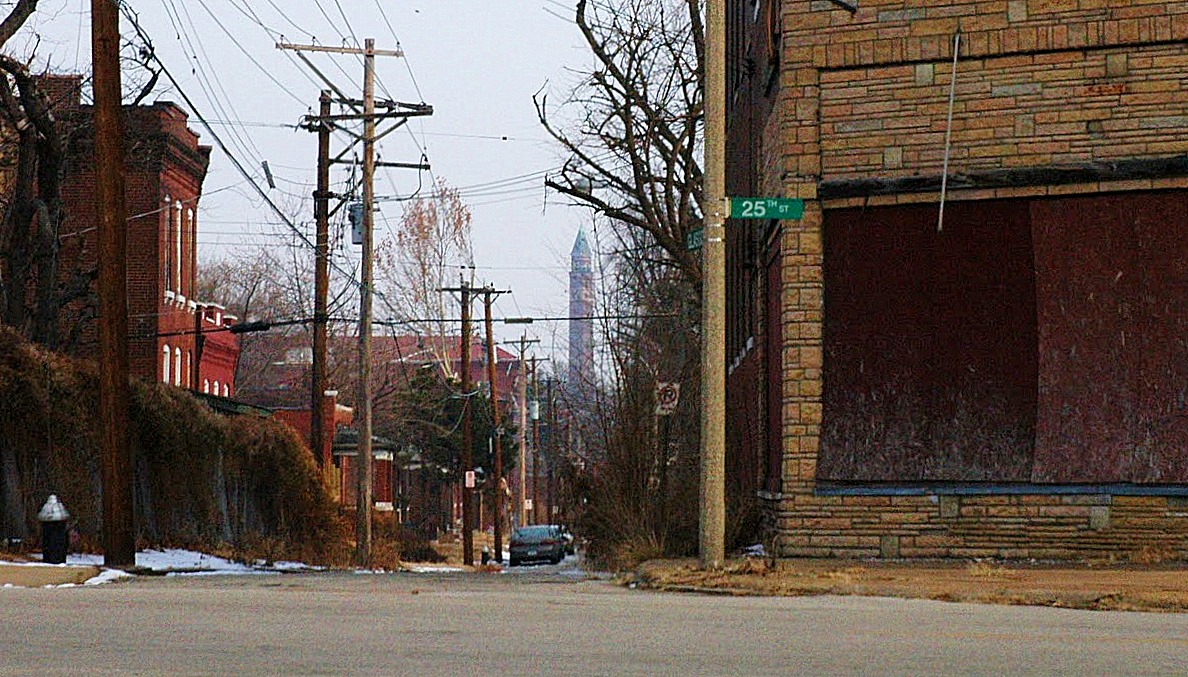
There are lots and lots and lots of dilapidated and crumbling structures new and old in Hyde Park today. But I just can’t put my finger on the way these neighborhoods make me feel. On one hand, it’s clearly depressing to witness, but on the other hand, you can’t help but notice the beauty and care that went into making this neighborhood an important place. The Germans that settled here did there best at making this a European-like self-contained turn of the 19th Century masterpiece of a neighborhood. Their diligence and good design can still be felt today, and it’s awe inspiring. There’s evidence of some positive efforts from those that have stuck it out over the years and maybe some new investment going into maintaining this place. Maybe enough to stabilize it for future generations to try to figure it out and fix it so it’s a show place and contributor to St. Louis status as the premier American city of neighborhoods.
There are small, yet noticeable rehabs and infrastructural upgrades that make me hopeful for the future. The bones of a the great neighborhoods are still here. But, the breakneck pace at which these neighborhoods emptied out is staggering. I think what I’m trying to convey is that, yes these places are depressing in their current state…and you may feel that way after looking at the pictures. But it’s invigorating as well. This is not one of the scary (as in getting a nonsensical verbal drubbing or at worse fear of getting rolled) neighborhoods of St. Louis. The overwhelming sentiment that I have when I see College Hill, Hyde Park, the Ville, Fountain Park and others is that we’ve hit rock bottom as a city. We can only go up. But the boarded up and falling structures are still the prominent scene on the backdrop of current day Hyde Park. But, but, it’s a worthy and important neighborhood. A key to our history and past that simply must be saved for future generations to enjoy and appreciate and consider as a place one would DESIRE to live.
Salisbury Street is a good example of how Hyde Park may be on the rise. There are some infrastructure upgrades right along the park including new sidewalks and street lamps. There is even a tastefully renovated storefront that houses a handsome little restaurant/cafe called Cornerstone Cafe.
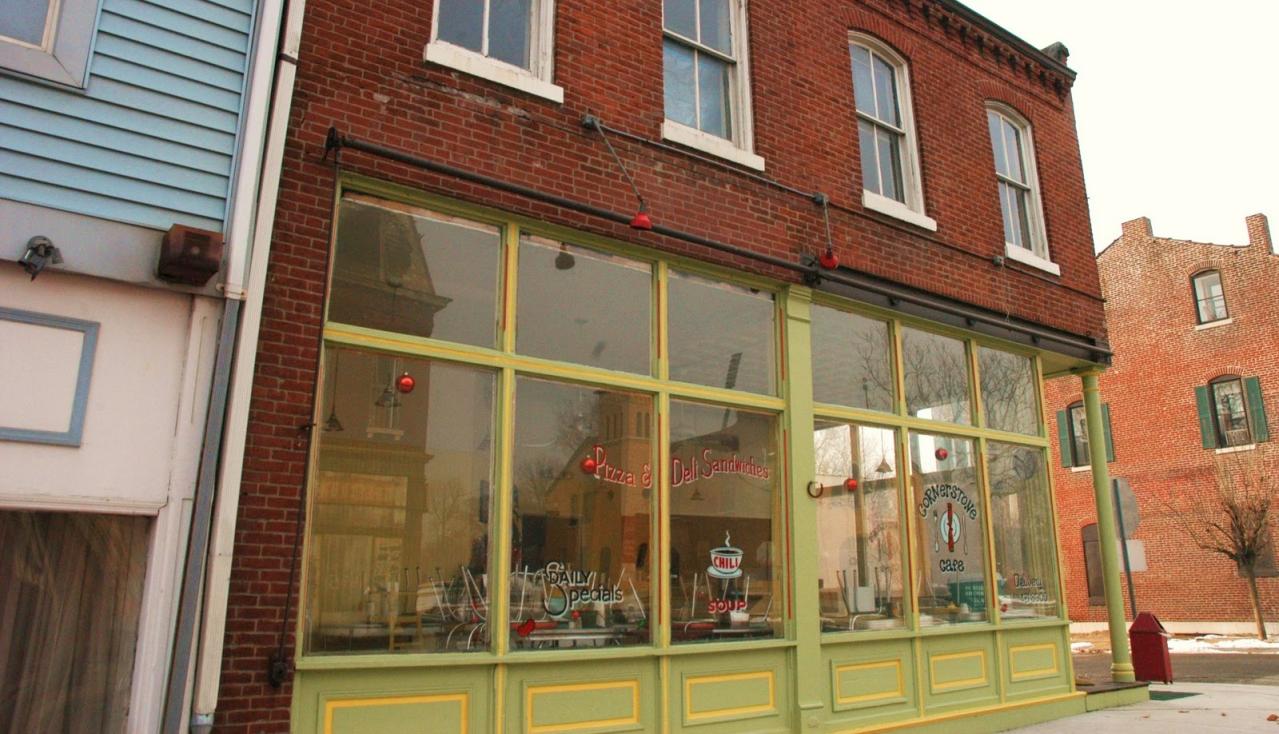
New sidewalks and street lights:
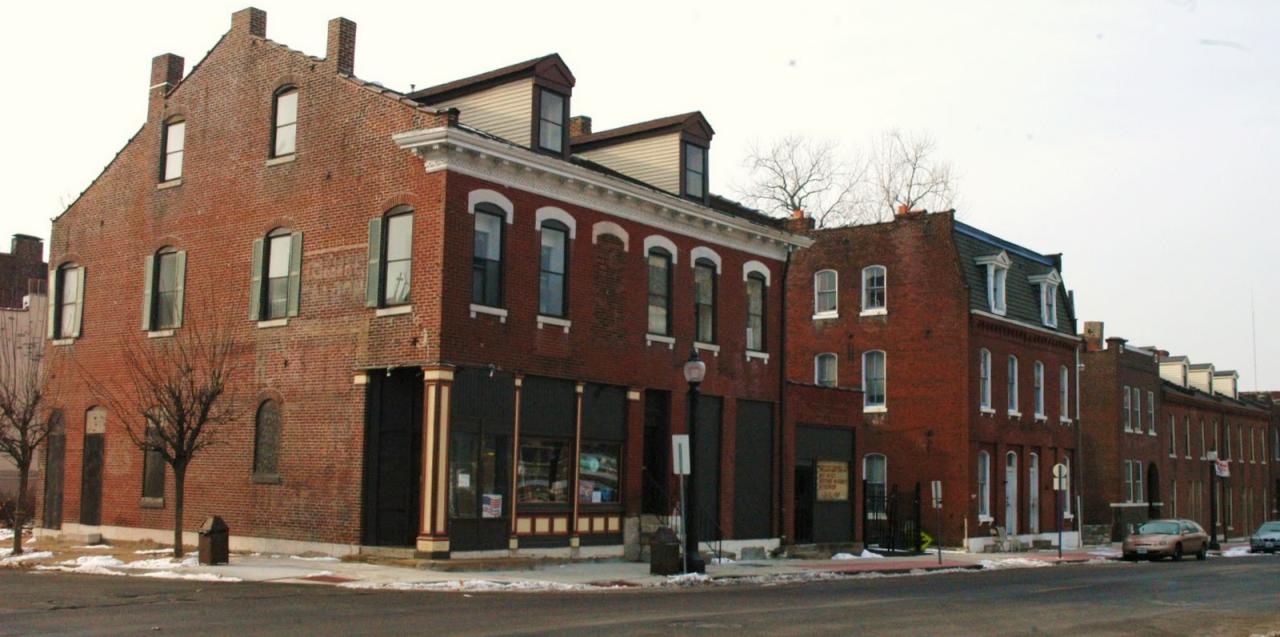
The building right across from it, you can still see the former Salisbury Variety and Dry Goods signs:
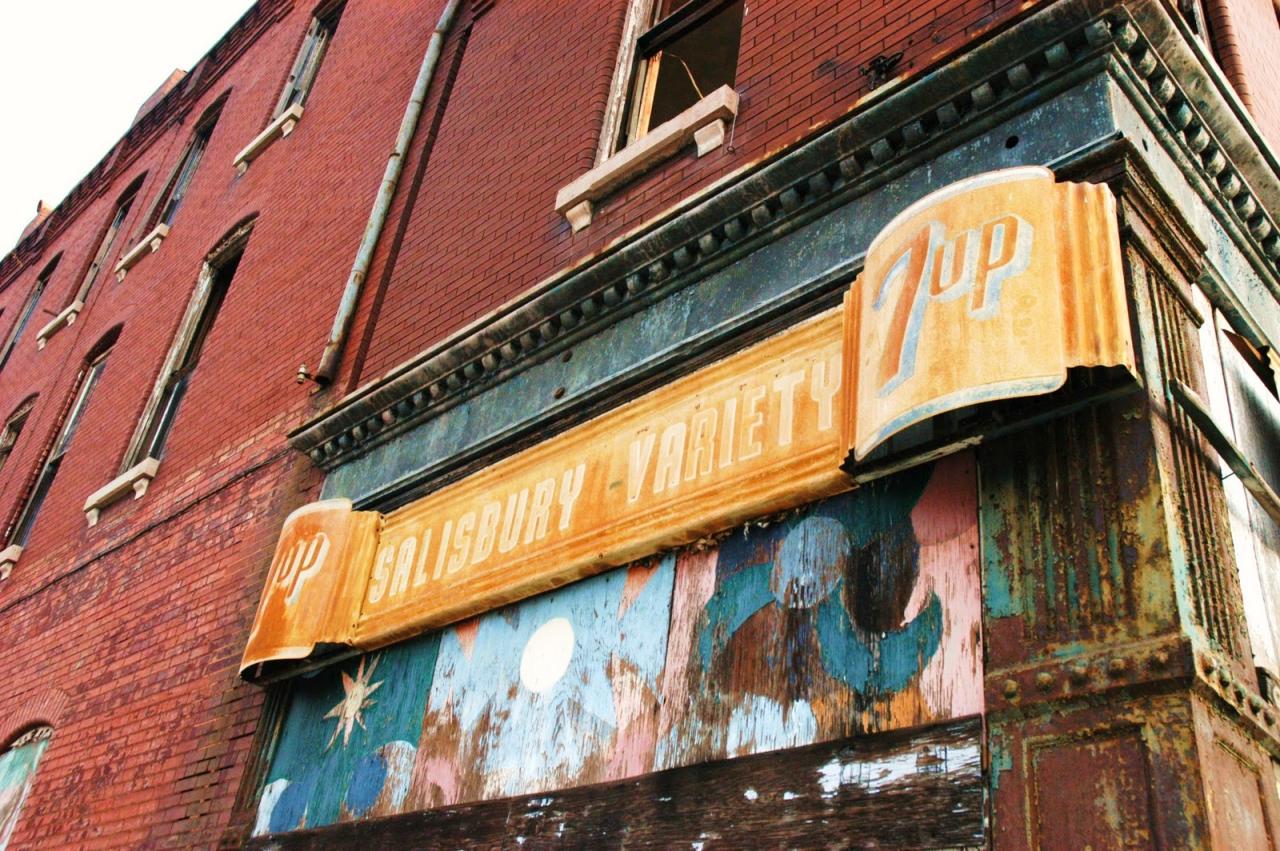
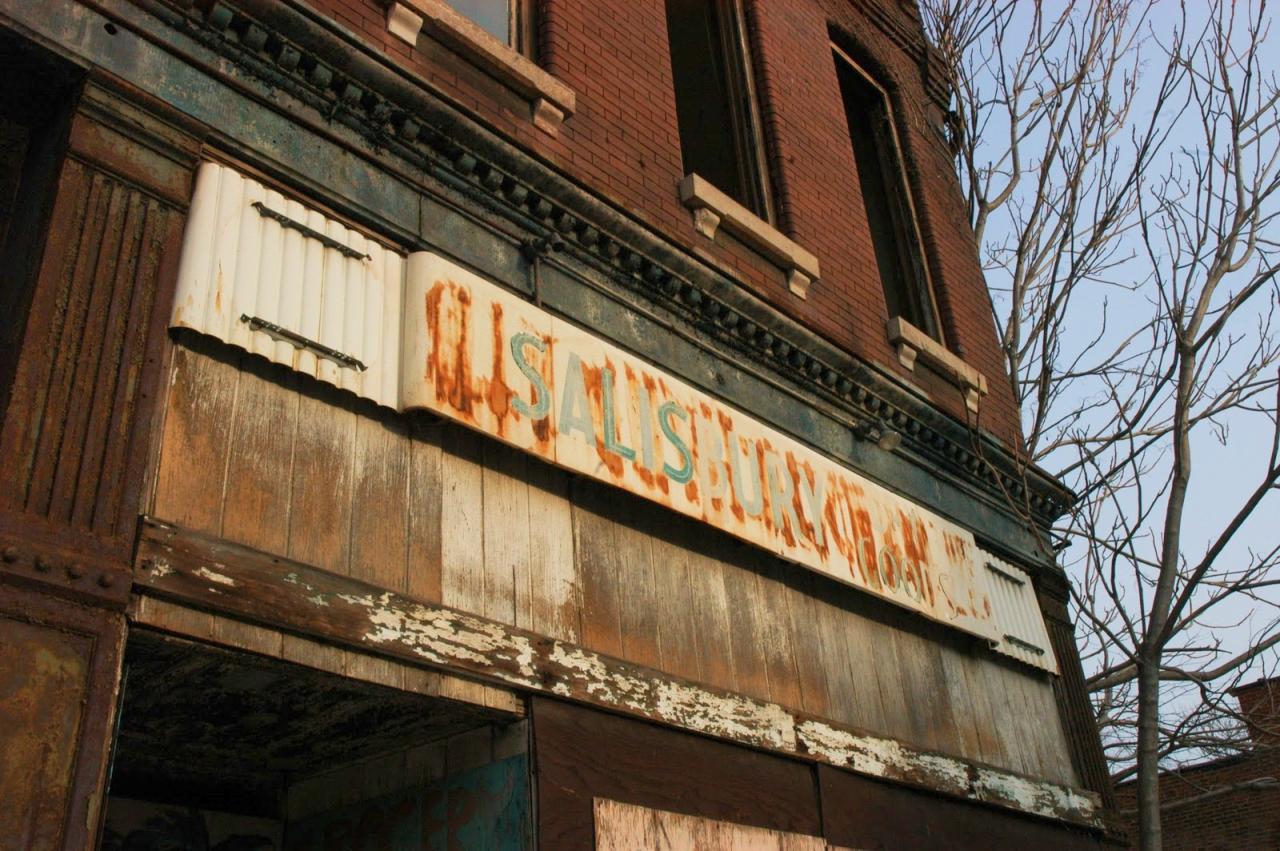
This area, arguably one of the most scenic and stable in Hyde Park still has constant reminders that the neighborhood is in various states of disrepair. The Nord St. Louis Turnverein is just down the street at Salisbury and 20th which once housed a gym, bowling alley, etc to serve as sort of a YMCA for the neighborhood was abandoned and boarded up until 2006 (photo from Built St. Louis):
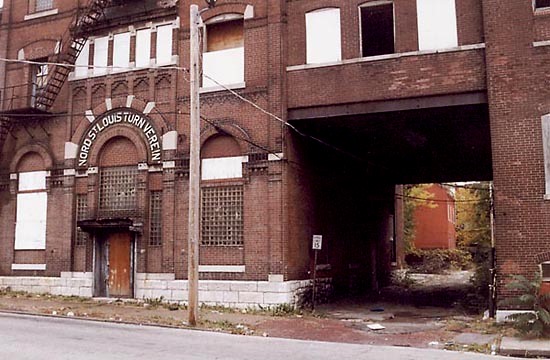
But a fire on July 4, 2006 (guess how that happened) pretty much destroyed the building. Of course it still sits in the same condition as it did after the fire:
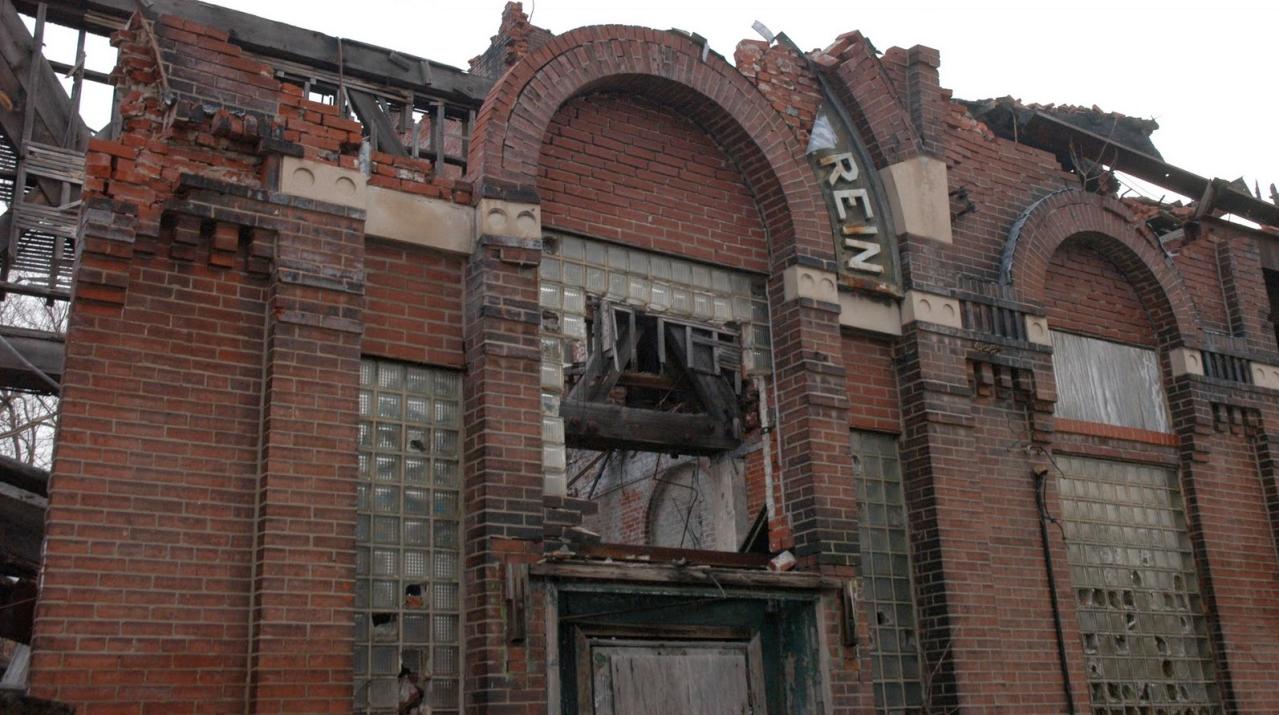

As with nearly every online research project I undertake, you’ll come to a careful and intelligent history of the Nord St. Louis Turnverein by Michael Allen on the Preservation Research Office website.
At one point you can tell that Hyde Park was a fully self-sustained neighborhood with residential and store fronts standing side by side with industry. The former Krey Meat Packing plant is a reminder of such and is quite a sight to behold in it’s day. It must have made for some pretty interesting sounds and smells for the people living around it. It’s now home to an auto salvage place (note the pile of transmissions in the next photo):
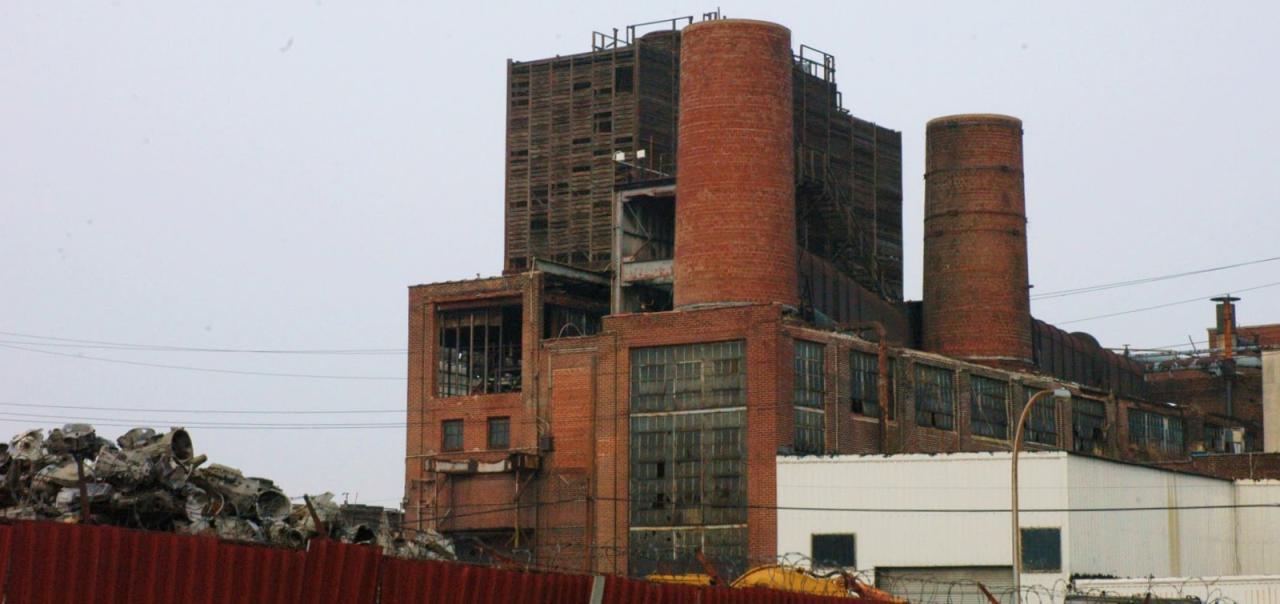
But man, what a cool old industrial complex:
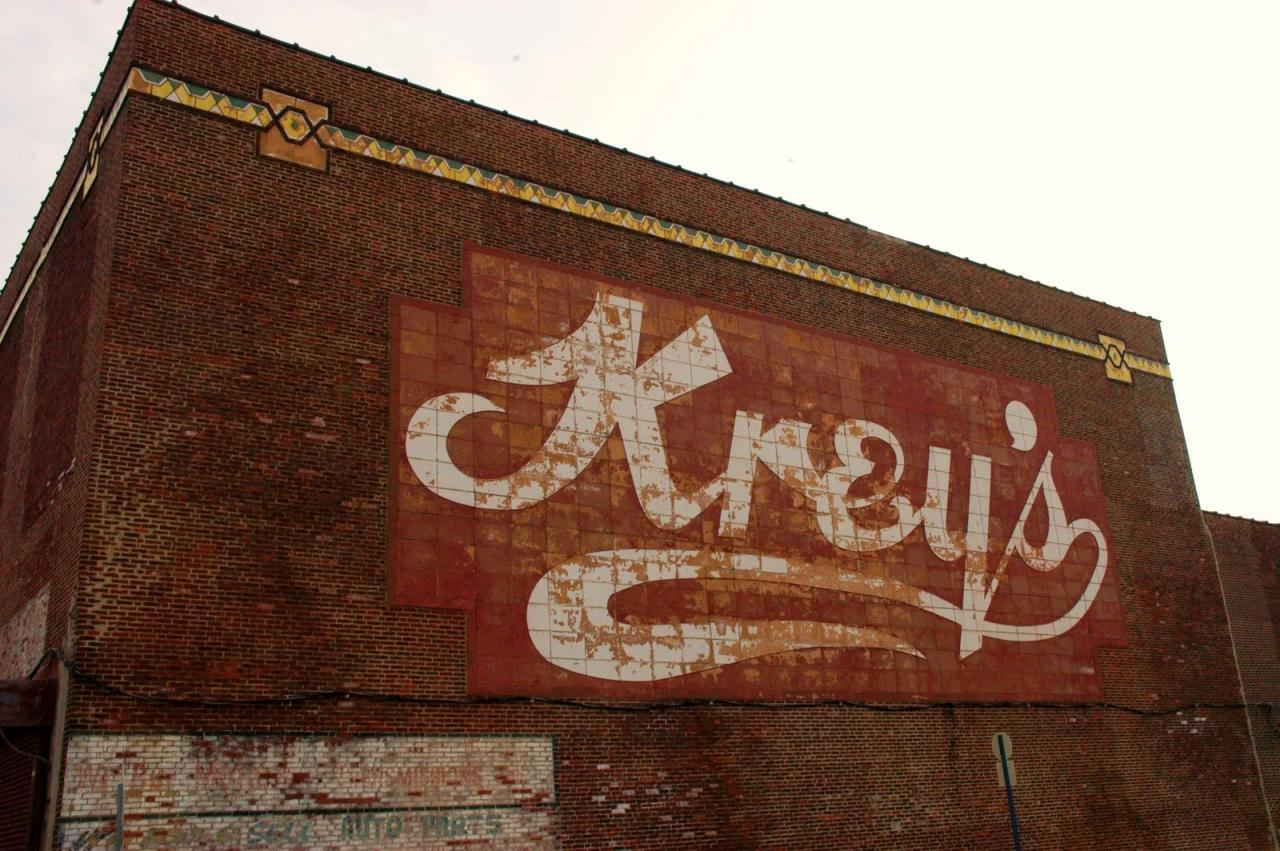
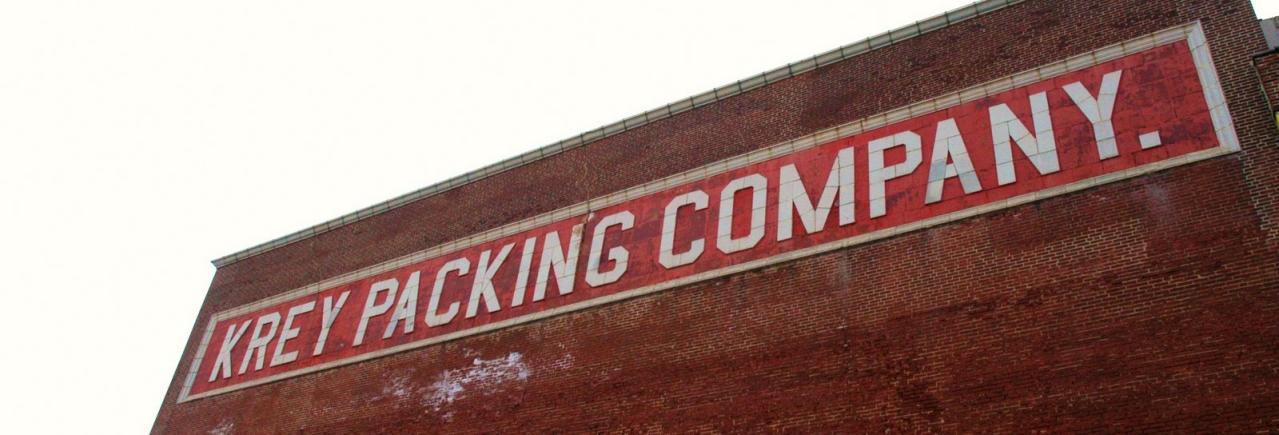

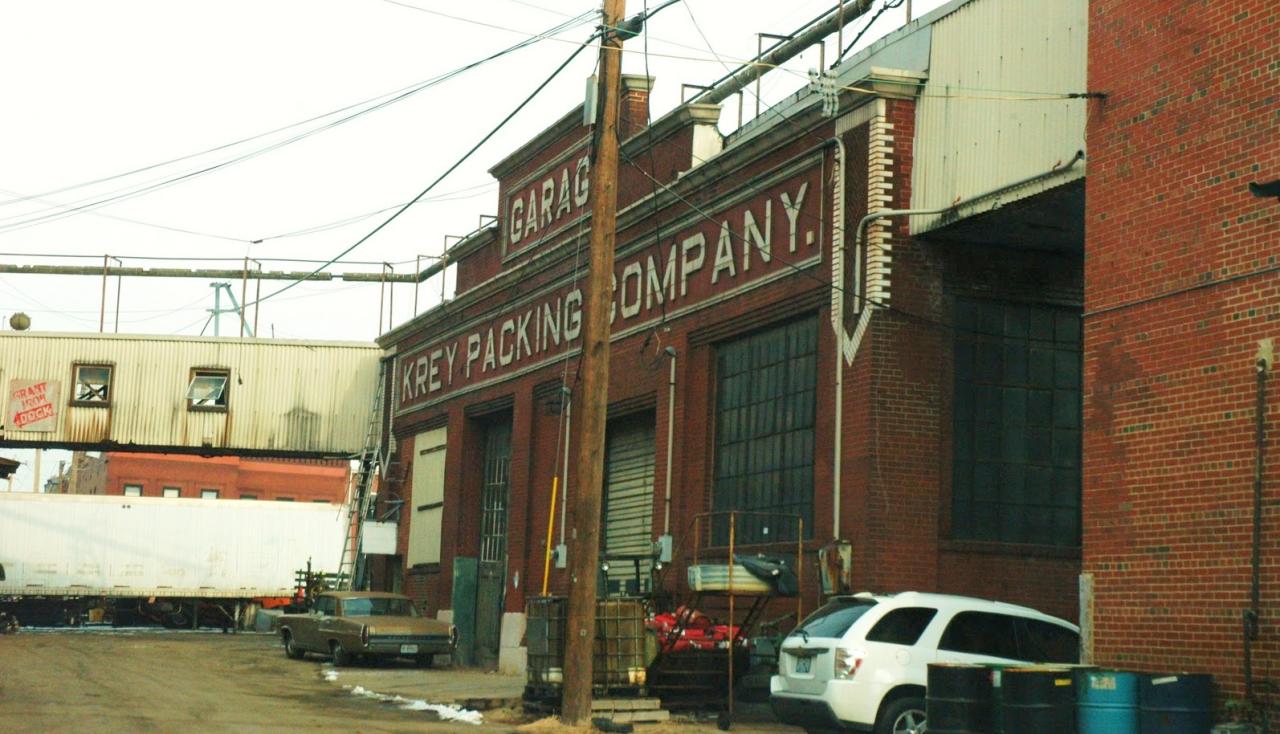
There are other signs of the former meat packing industry in Hyde Park with the former Gruensfelder Meat Packing building:
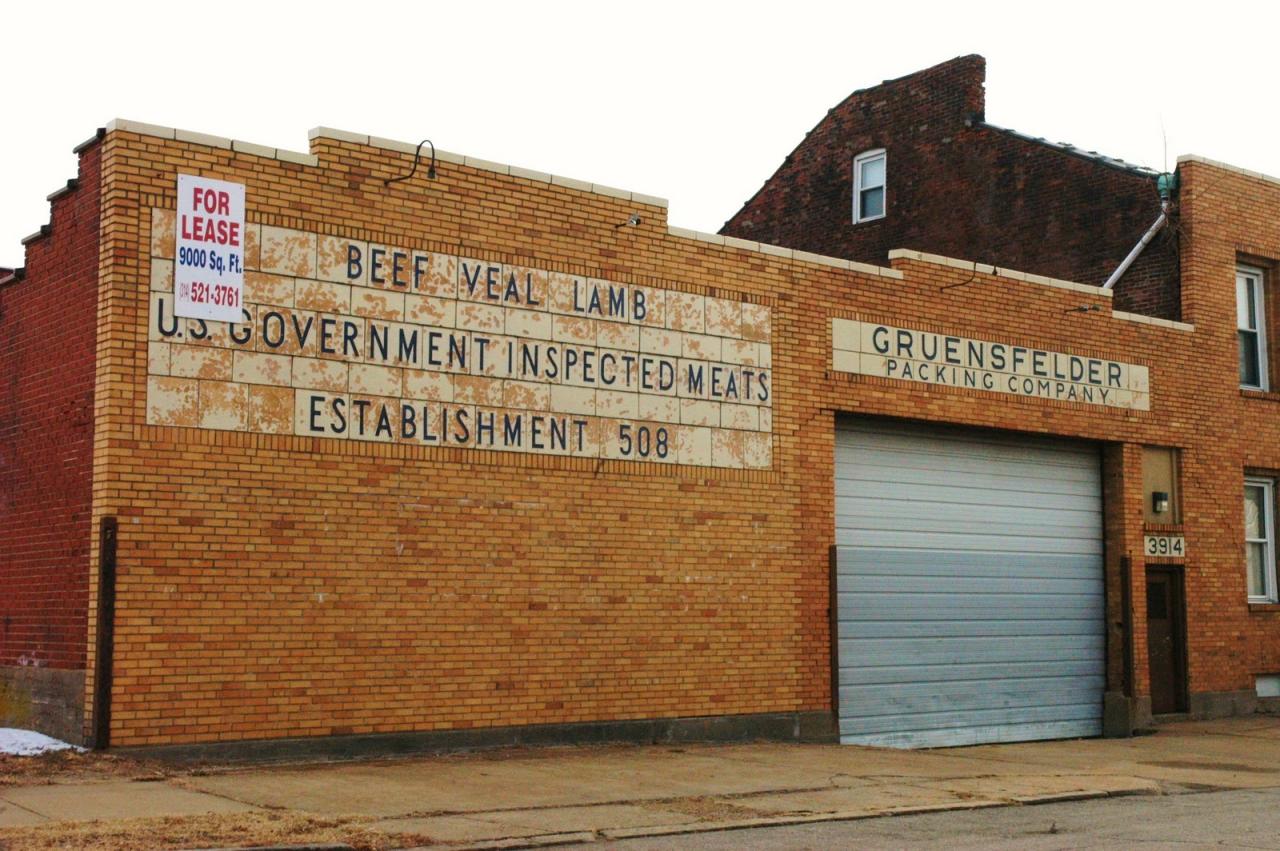

There are stories of cattle being ushered through the streets of Bremen from the Union Stock Yards on Bremen Avenue to the slaughterhouses in the neighborhood. I’ve also read personal accounts of the sounds of pigs being ushered into Krey’s.
There is one remaining connection to the ways of the glory days of the neighborhood: Piekutowski’s Sausage shop located at 4100 N. Florrisant Ave right at Angelica Street. This place is worth checking out because of a delicious Polish smoked sausage called Krakow. This stuff is dynamite and the storefront is a throw back to the neighborhood stores of old. Here’s what it looks like today:
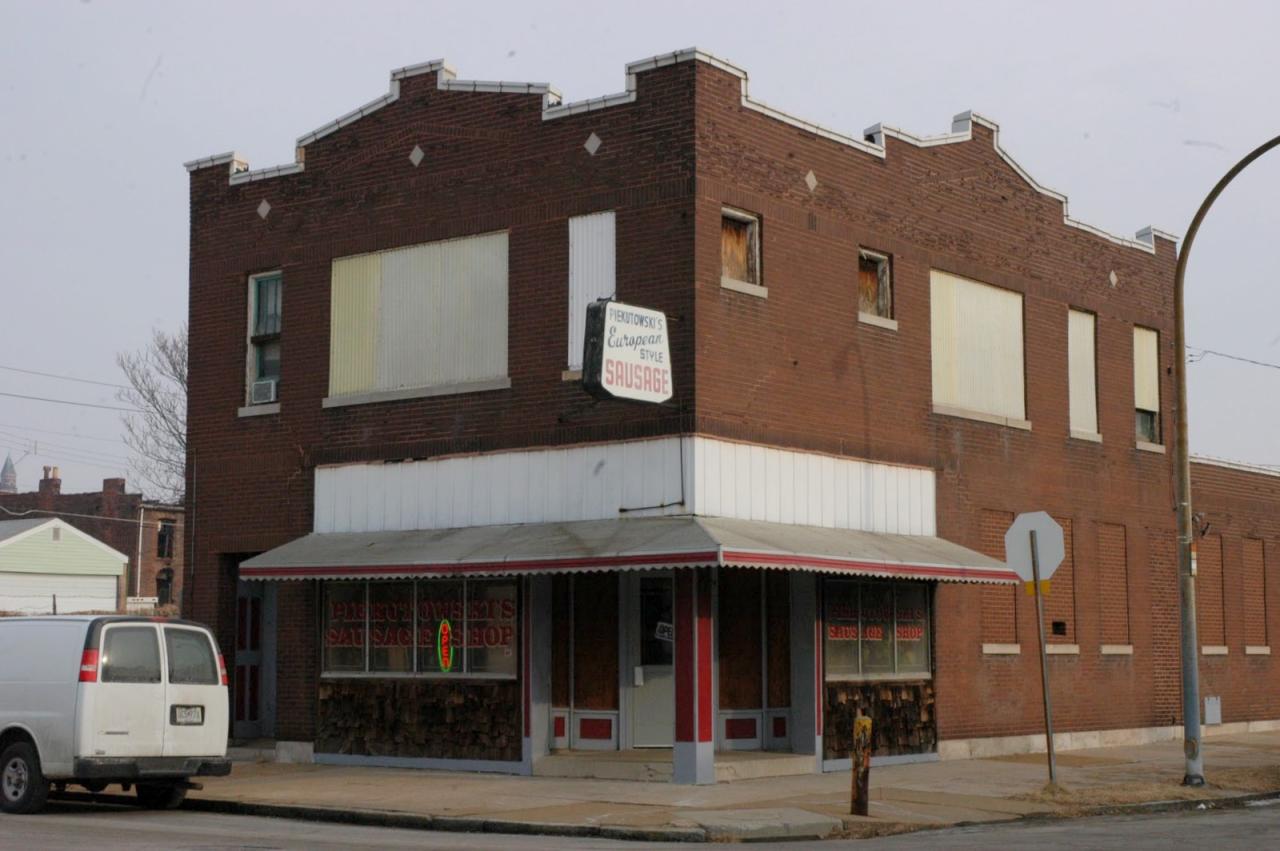
Piekowski’s had a moment in the spotlight back in 1999 when Pope John Paul II (he of Polish decent) visited St. Louis and stopped into the Hyde Park establishment for some Krakow. There is now a bust of the Pope behind the counter. I believe the store keeper told me that they’ve been in Hyde Park for 70 years, and they were at Cass/10th before that.
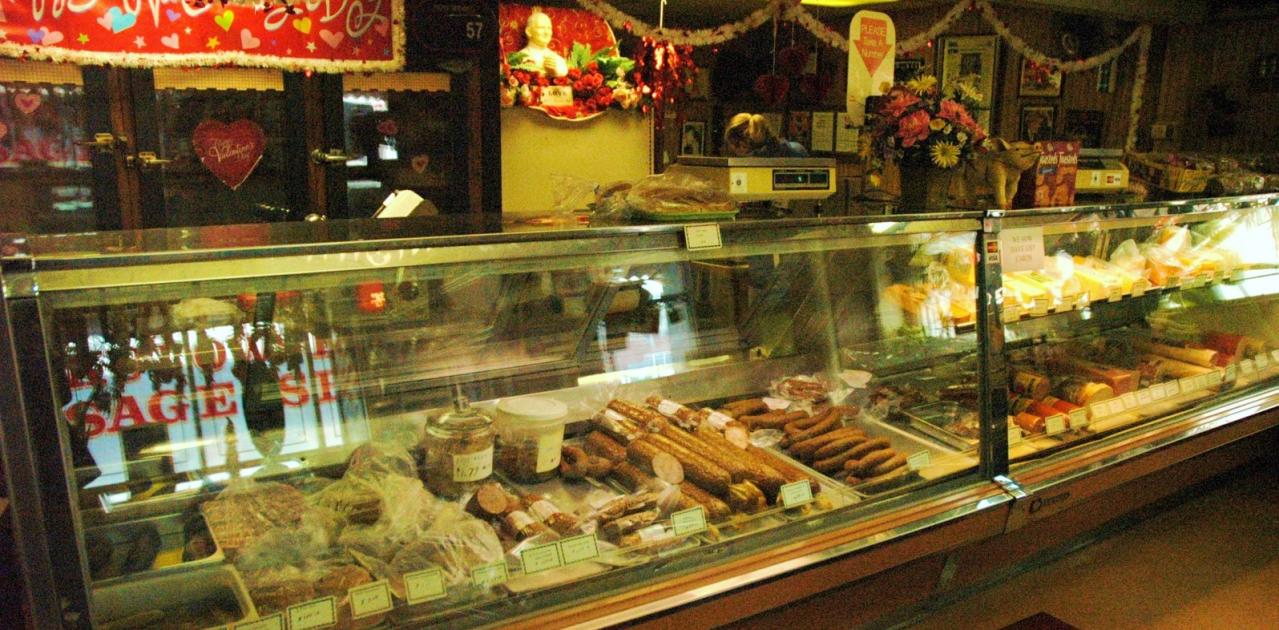
There are couple other places worth noting, the Casa Blanca II right across the street from Piekutowski’s and Miss Bettys Restaurant Hall and Lounge right across from the former Krey Meat Packing factory.
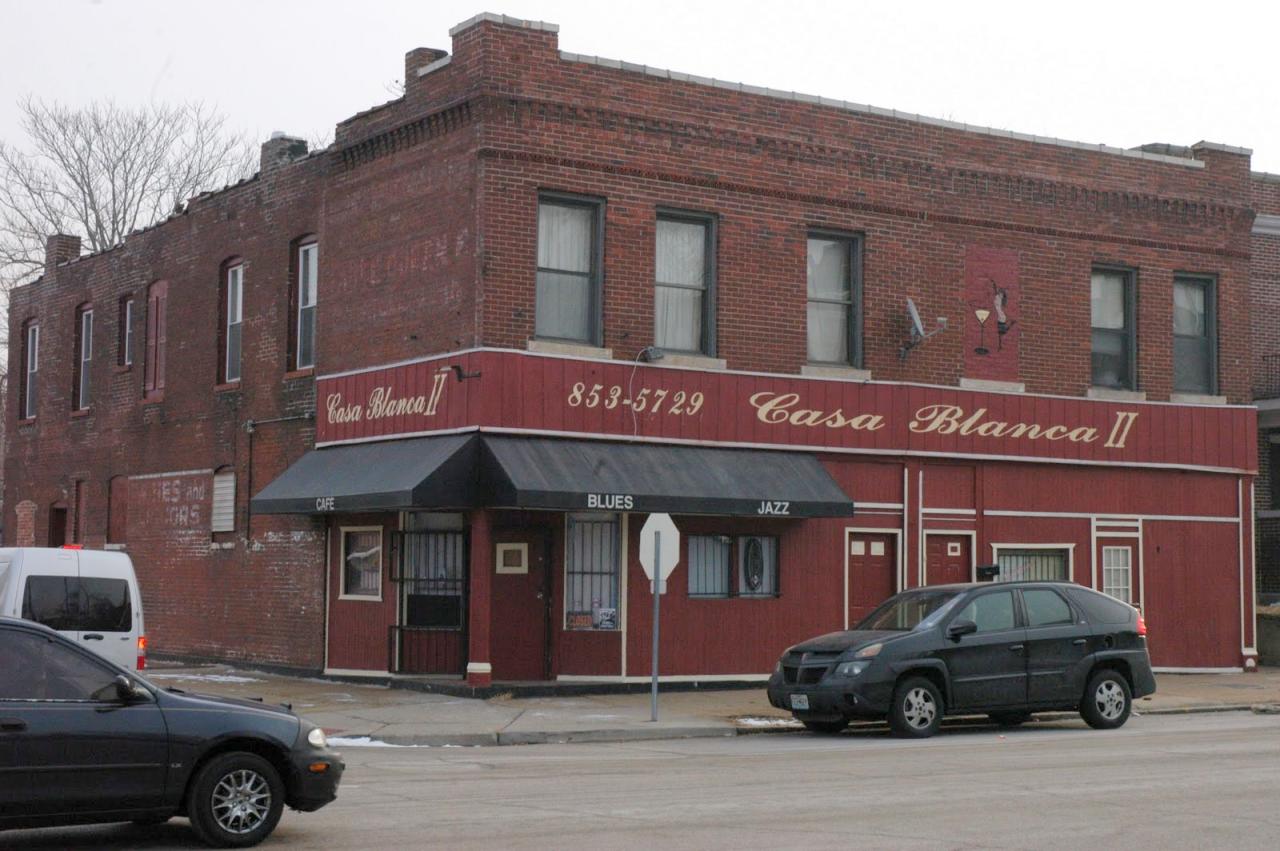
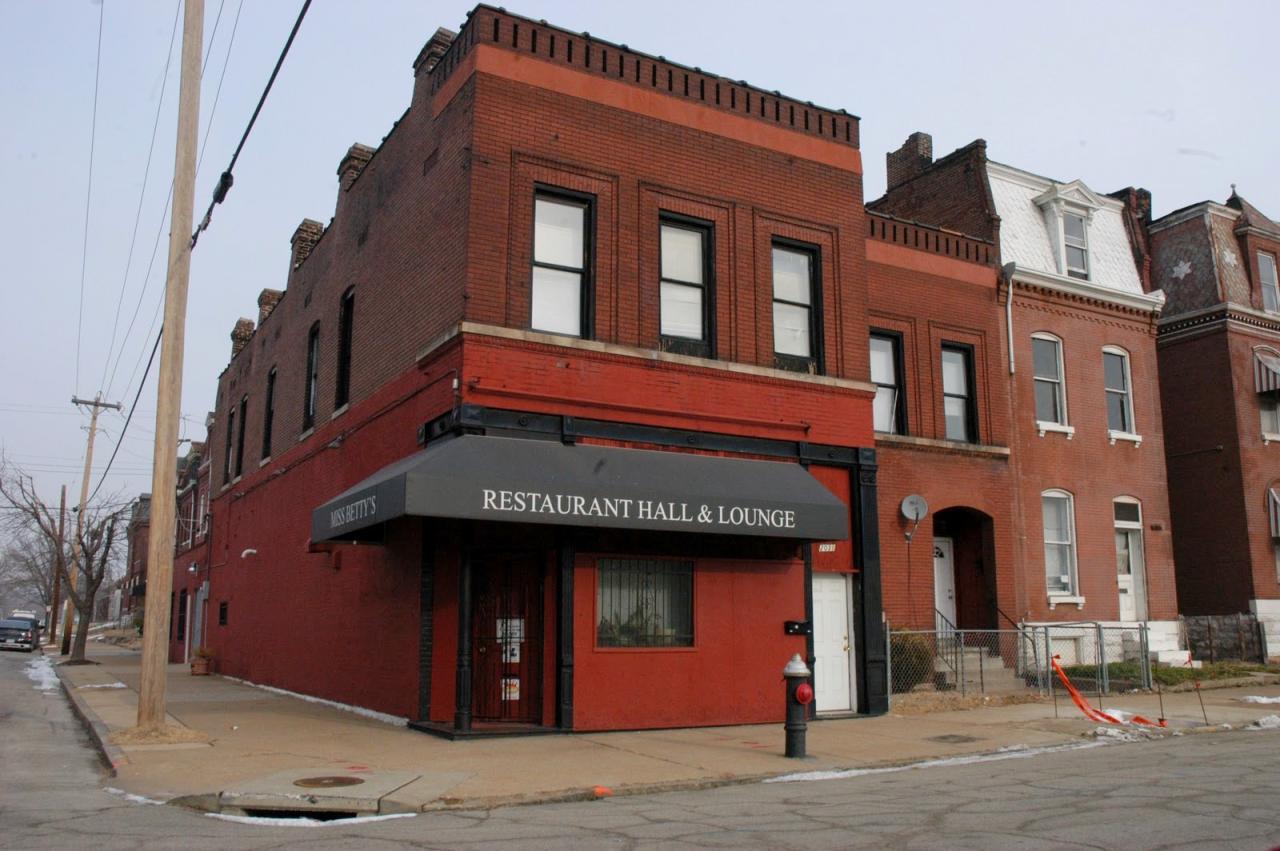
And what German settlement would be complete without its own brewery. Well Hyde Park certainly lived up to the bill with the Hyde Park Brewery (from the City of St. Louis website):
A neighborhood fixture for many years was the Hyde Park Brewery, which was founded in 1876 and was sold to the St. Louis Brewing Association in 1889. The plant at 3607 North Florissant was a major unit in the Association until prohibition. After repeal in 1933, the plant was acquired by independent operators, who sold it in 1948 to the Griesedieck-Western Brewery Company of Belleville, Illinois. That firm became a unit of the Carling Company in 1953, who produced Hyde Park beer at the North Florissant plant until 1958.
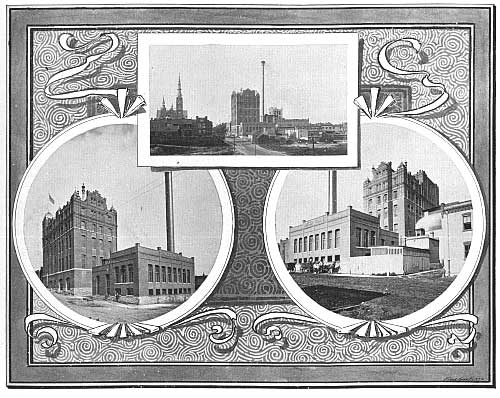
Some pundits claim that Hyde Park beer was the first to use television to advertise their product (from beerhistory.com):
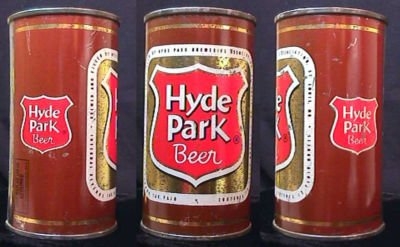 Modern Brewery Age magazine christened the Hyde Park brewery of St. Louis the “first brewery to sponsor a televised program anywhere.” It was February 1947, and St. Louis was launching its inaugural television broadcast, consisting of a man-on-the-street interviewer talking to local residents. Hyde Park’s early commercials–perhaps history’s first prerecorded beer spots–featured “Albert, The Stick Man,” an animated cartoon character with a knack for finding trouble. Whatever Albert’s dilemma, a bottle of Hyde Park Beer always brought relief.
Modern Brewery Age magazine christened the Hyde Park brewery of St. Louis the “first brewery to sponsor a televised program anywhere.” It was February 1947, and St. Louis was launching its inaugural television broadcast, consisting of a man-on-the-street interviewer talking to local residents. Hyde Park’s early commercials–perhaps history’s first prerecorded beer spots–featured “Albert, The Stick Man,” an animated cartoon character with a knack for finding trouble. Whatever Albert’s dilemma, a bottle of Hyde Park Beer always brought relief.
I believe the brewery was demolished.
But there are some ghost signs that serve as reminders of the old days when this was a thriving area:
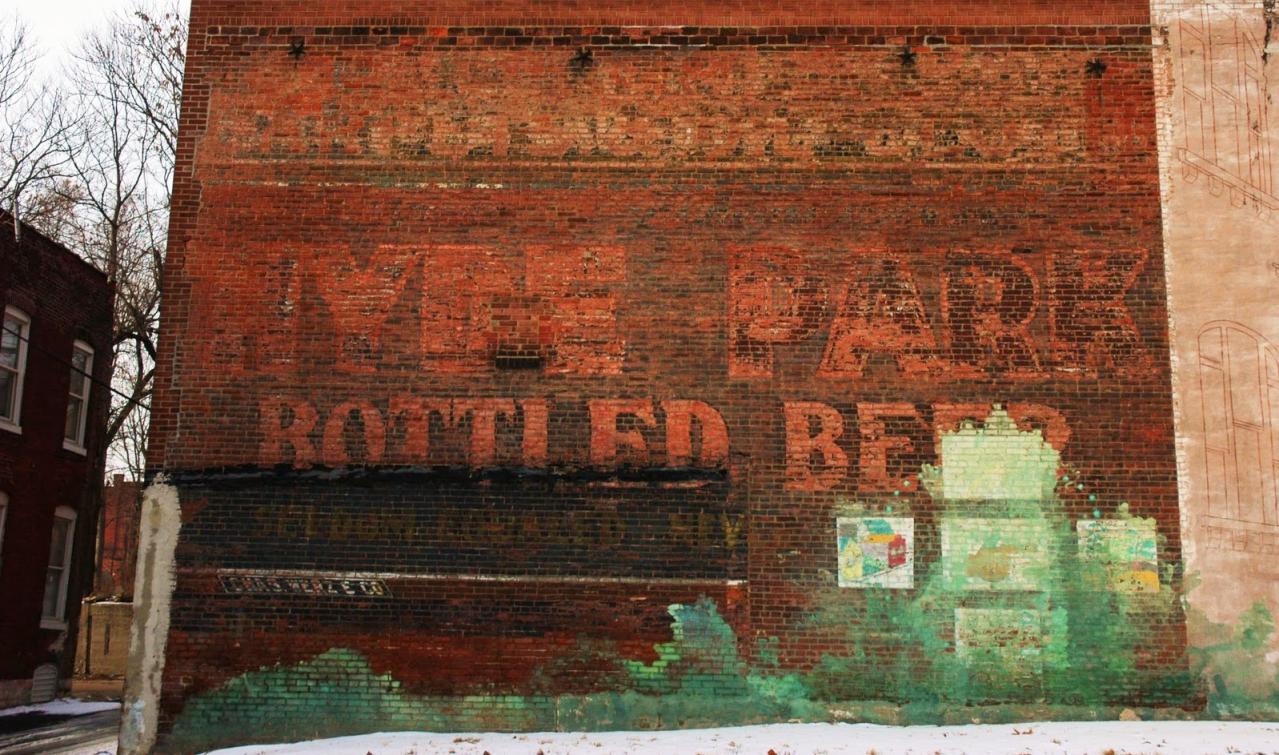
Here are some other relics from the past that caught my eye:
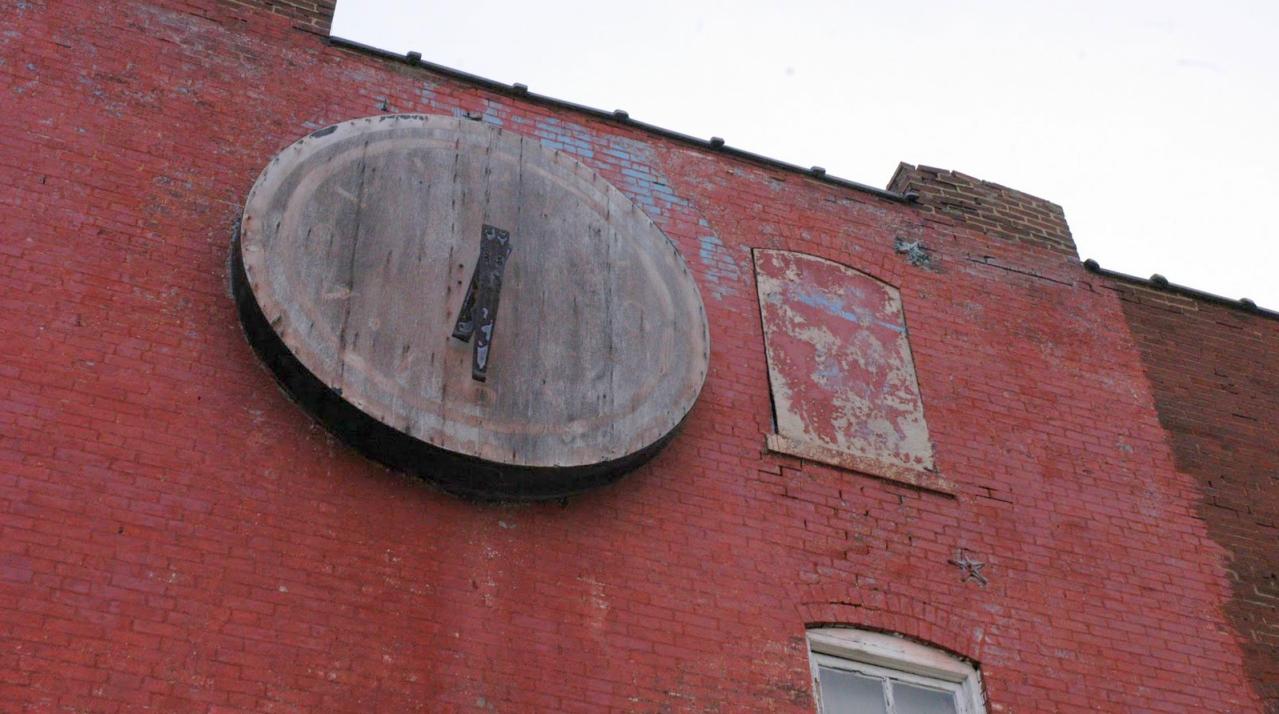
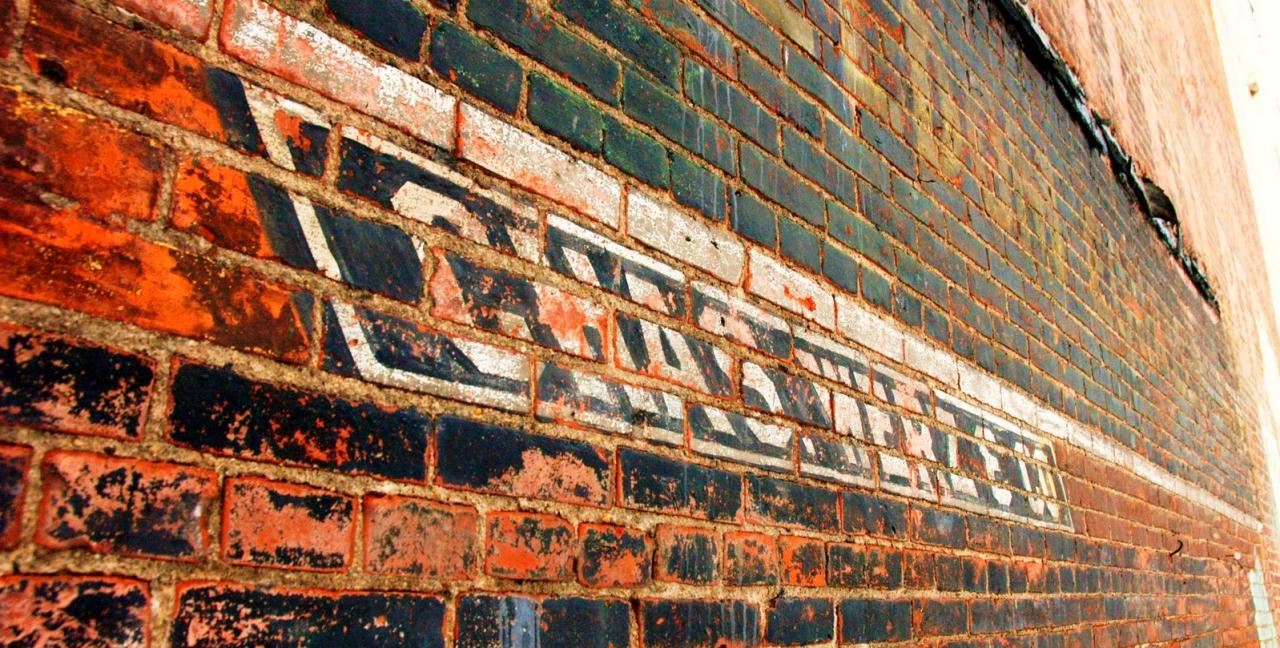
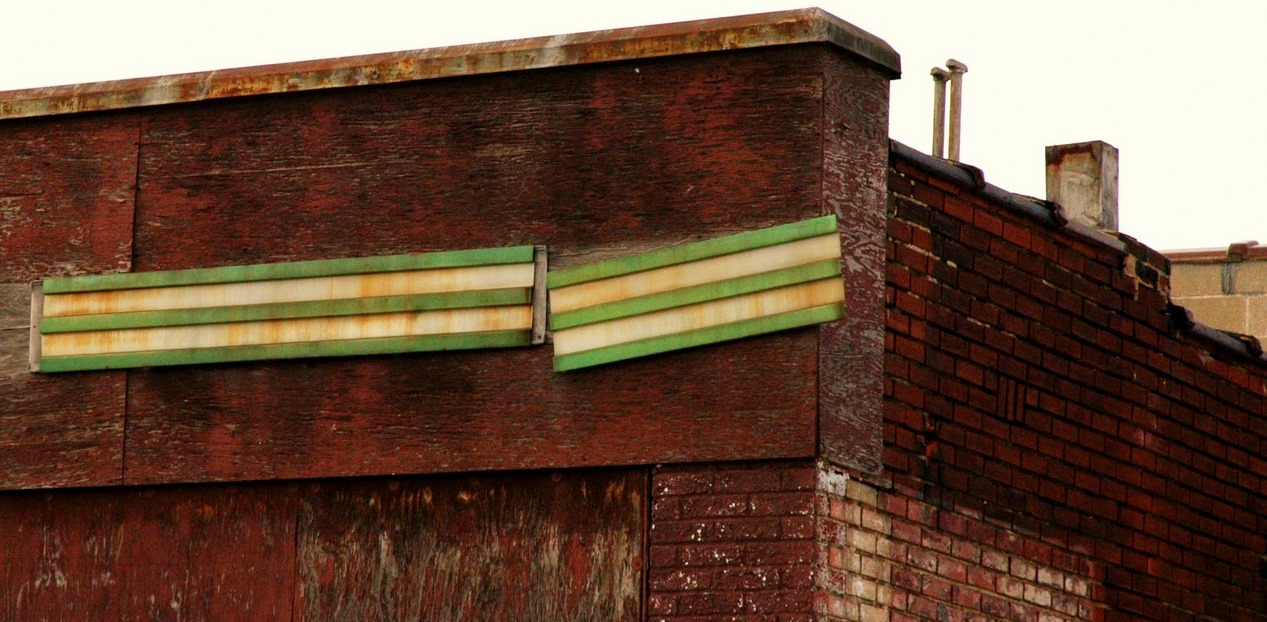
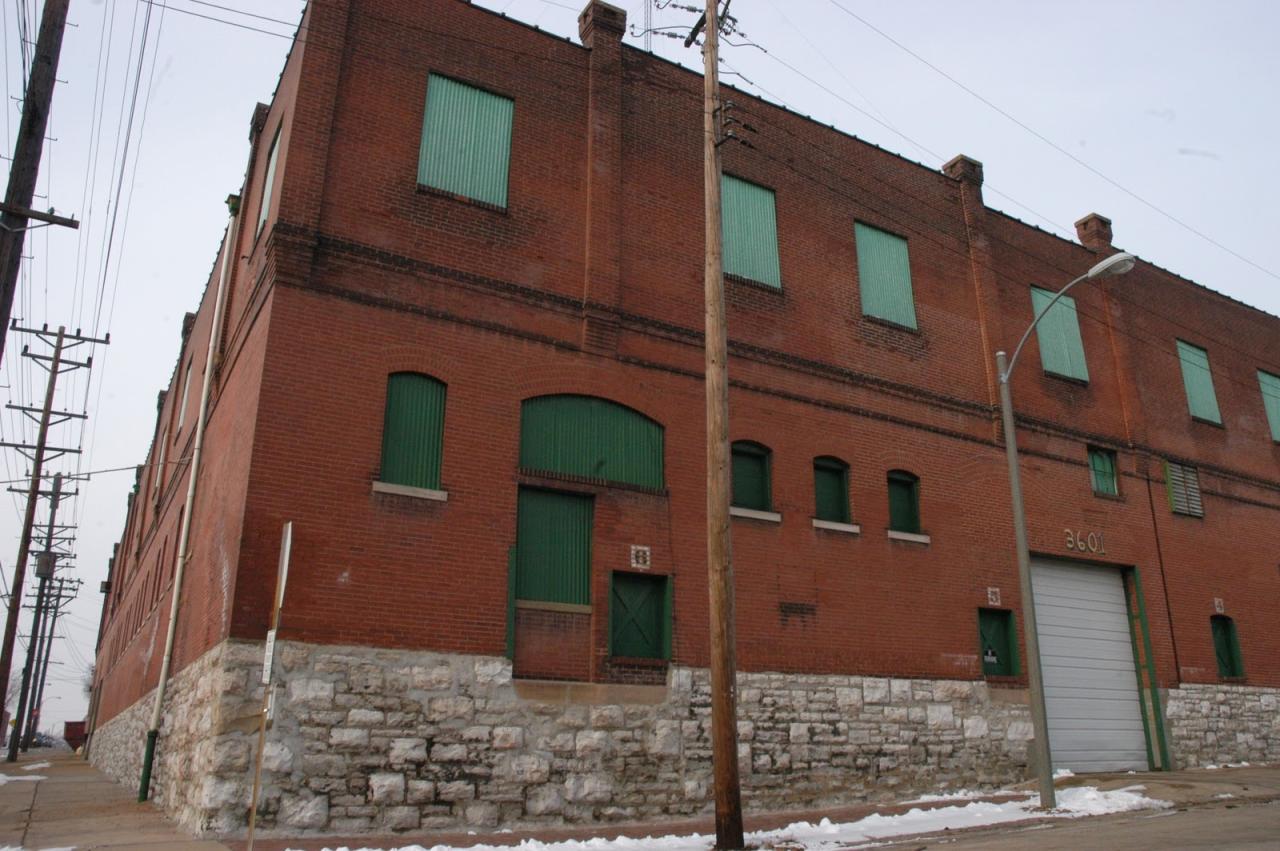
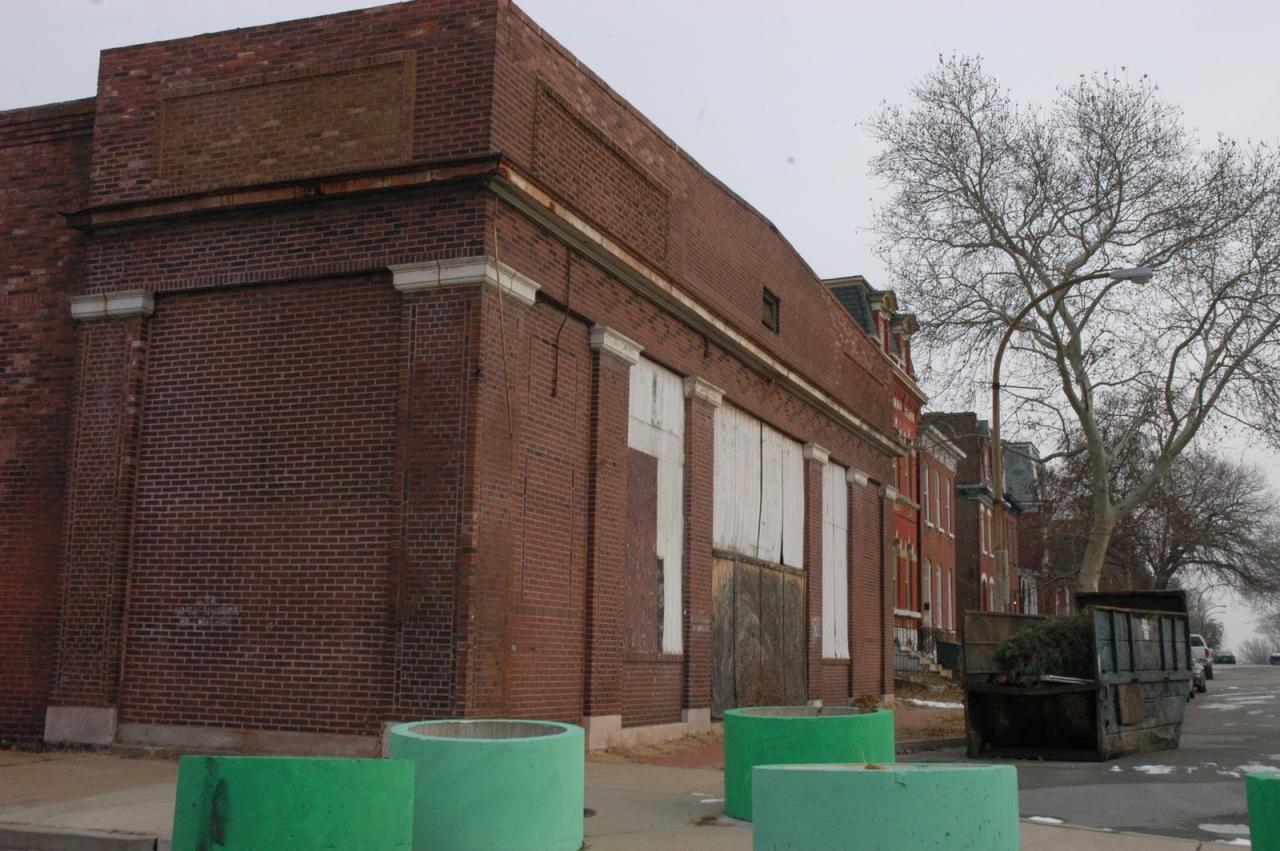
Can anyone tell me what this long building was? Looks kind of like a train station:
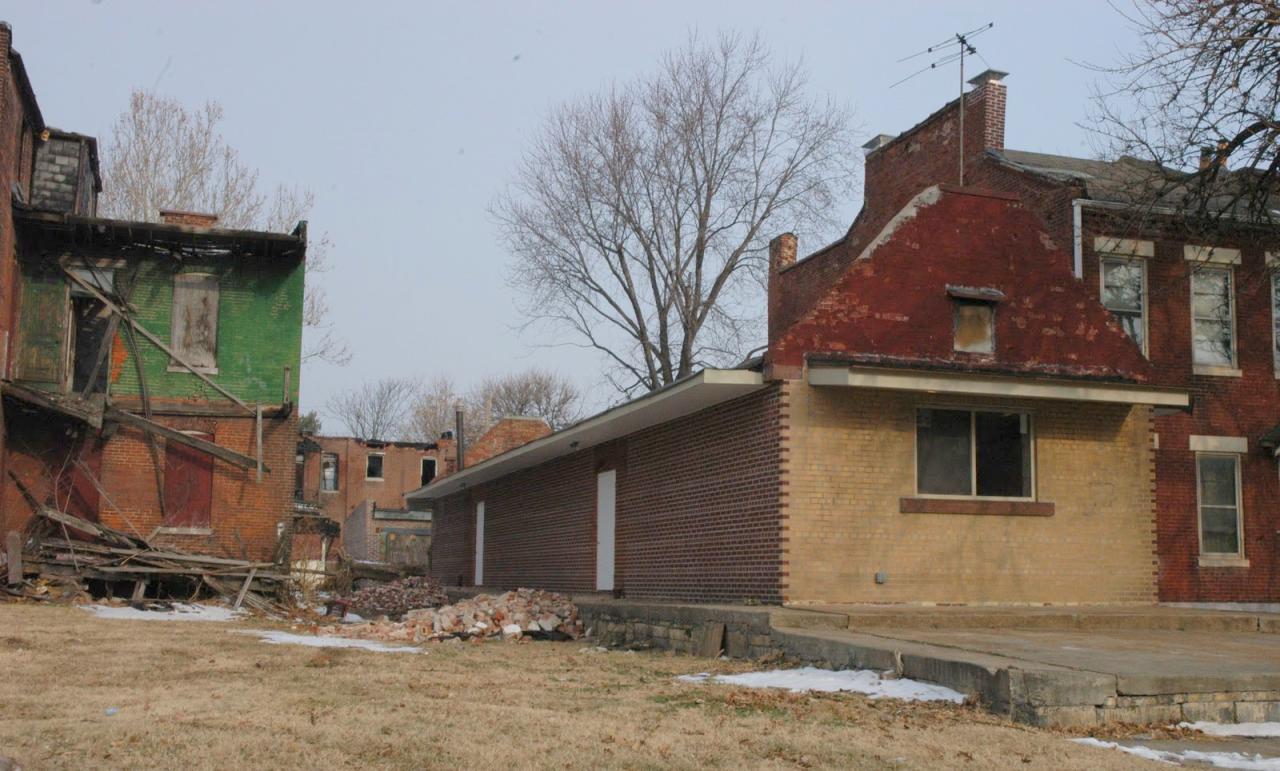
The housing stock is/was amazing. With the exception of one area of small shotguns that can be seen in almost every neighborhood in St. Louis:
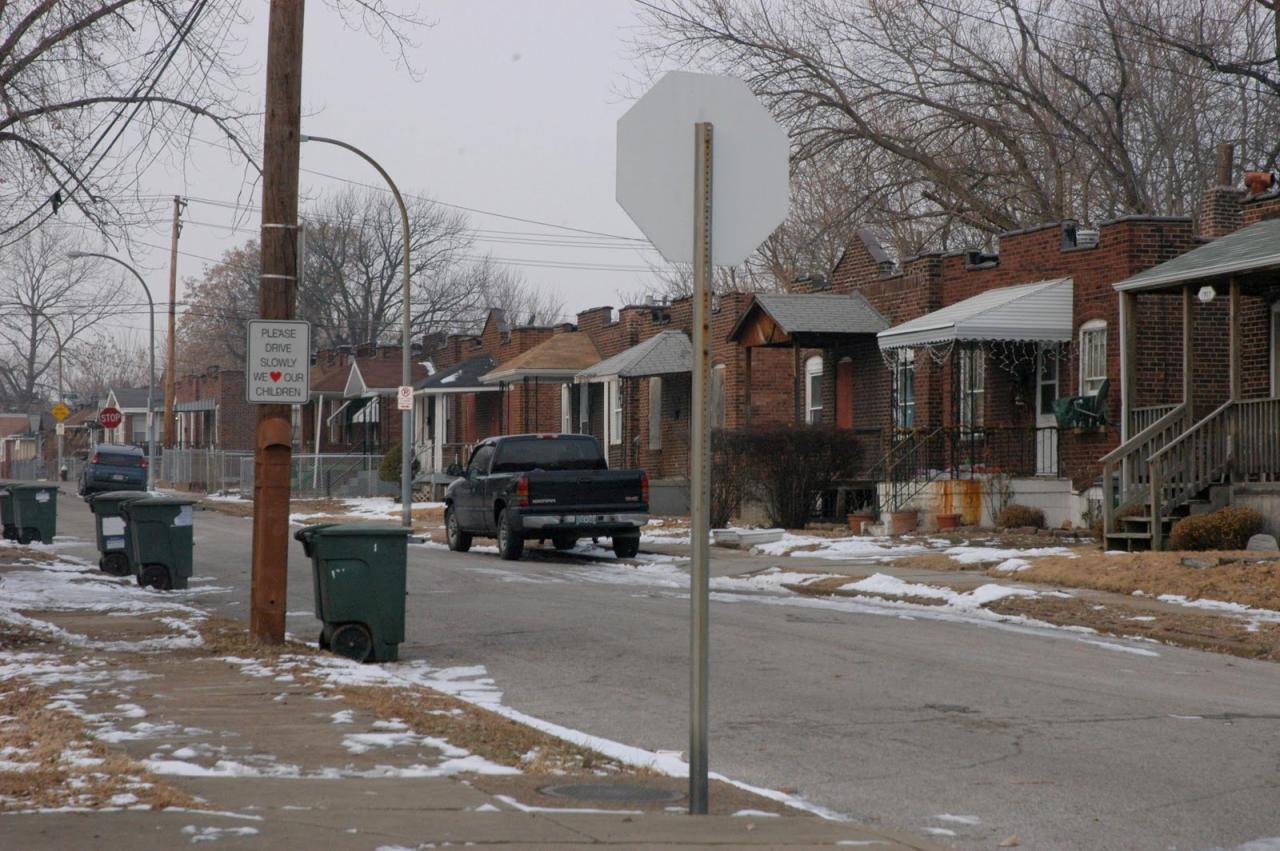
The prevailing style are the row houses and mansions that can best be viewed in neighborhoods like Soulard, LaSalle or Benton Park. Here are some of my favorites:
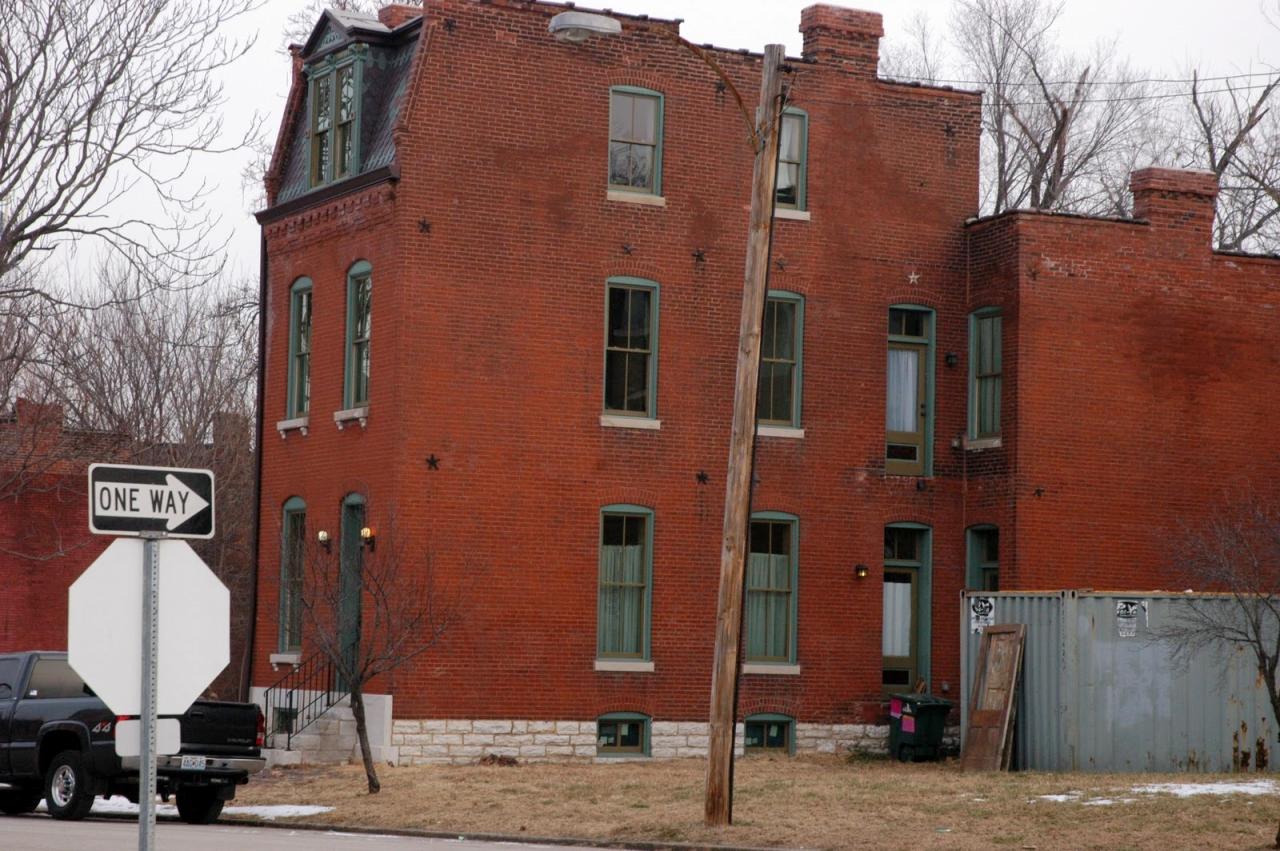
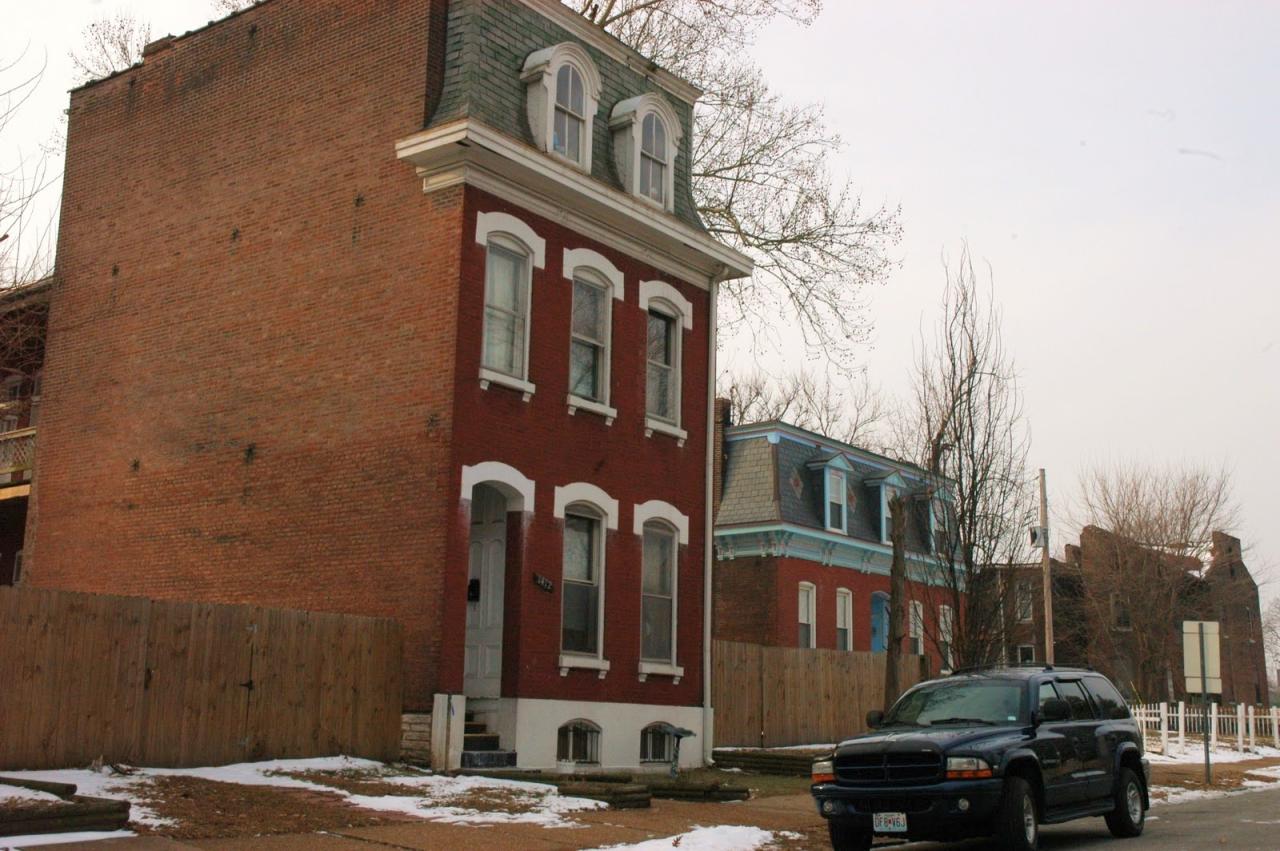
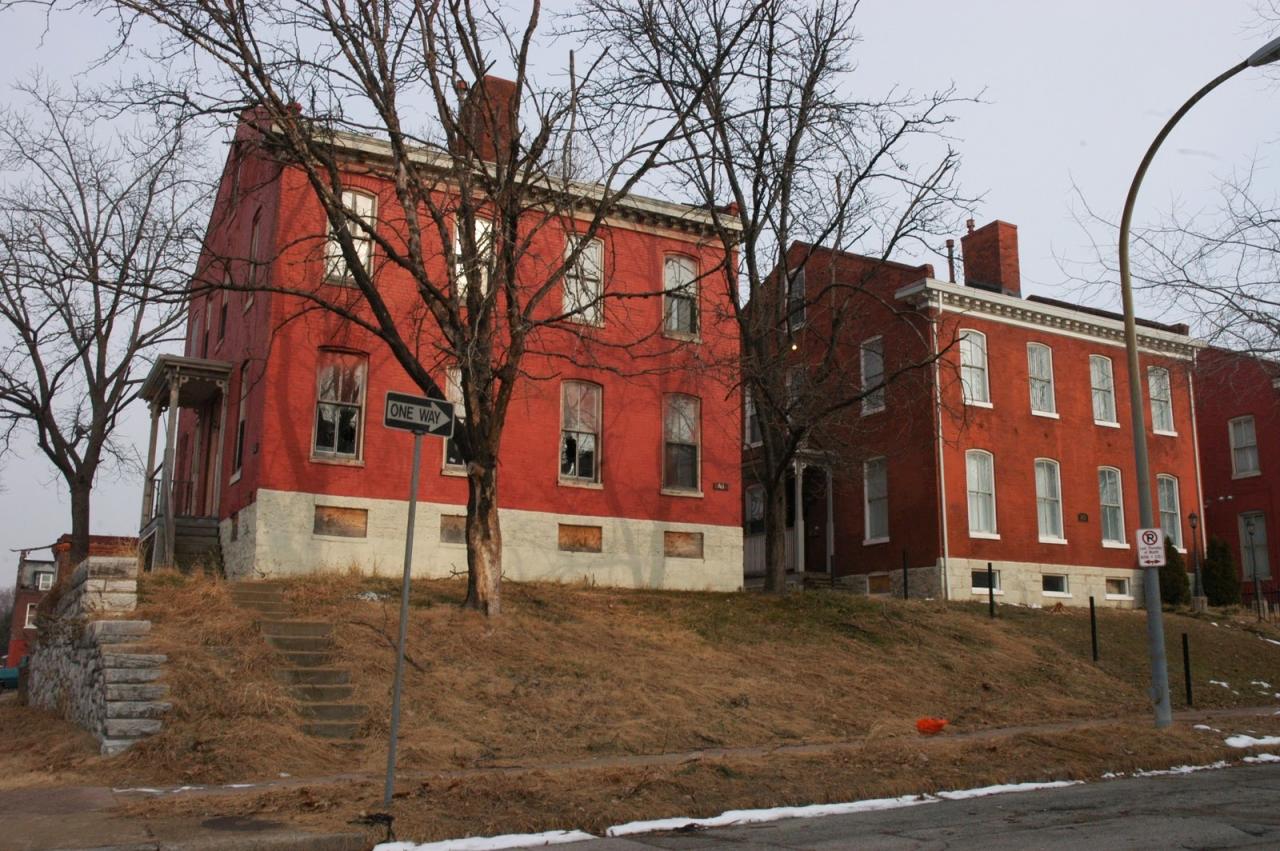
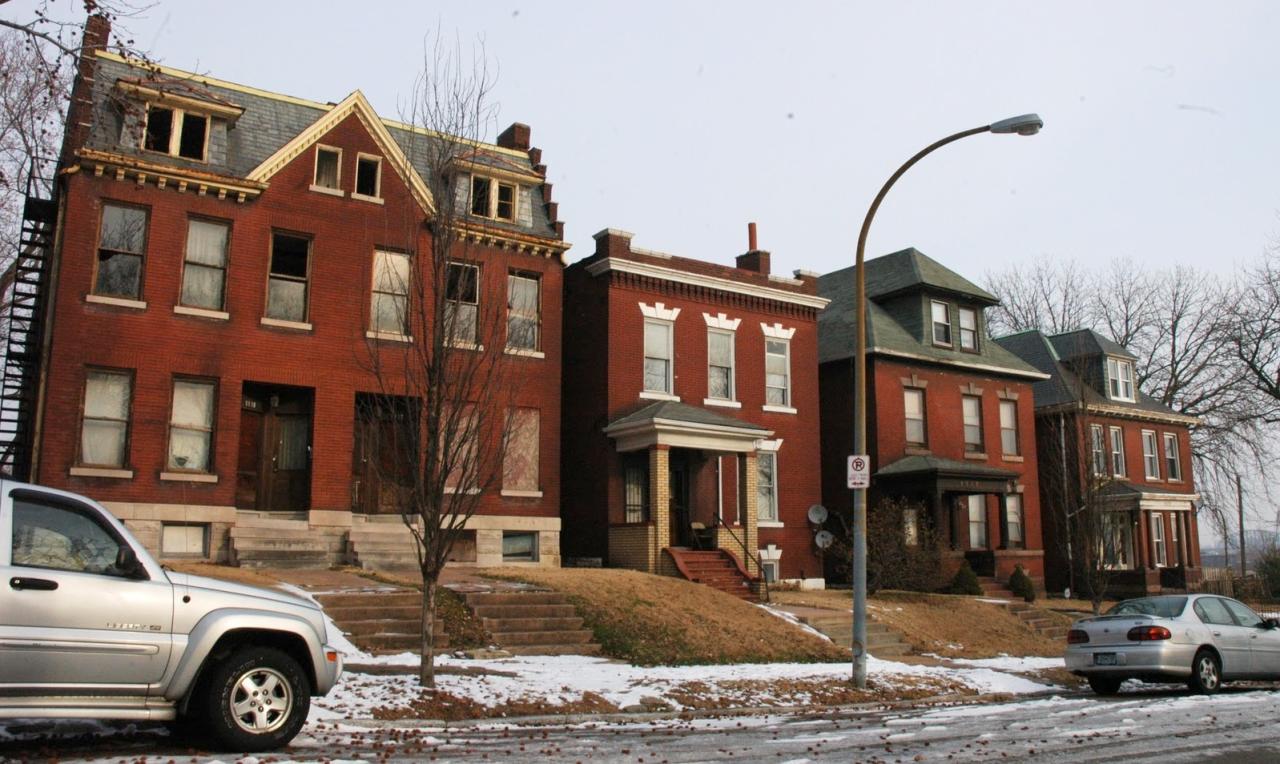
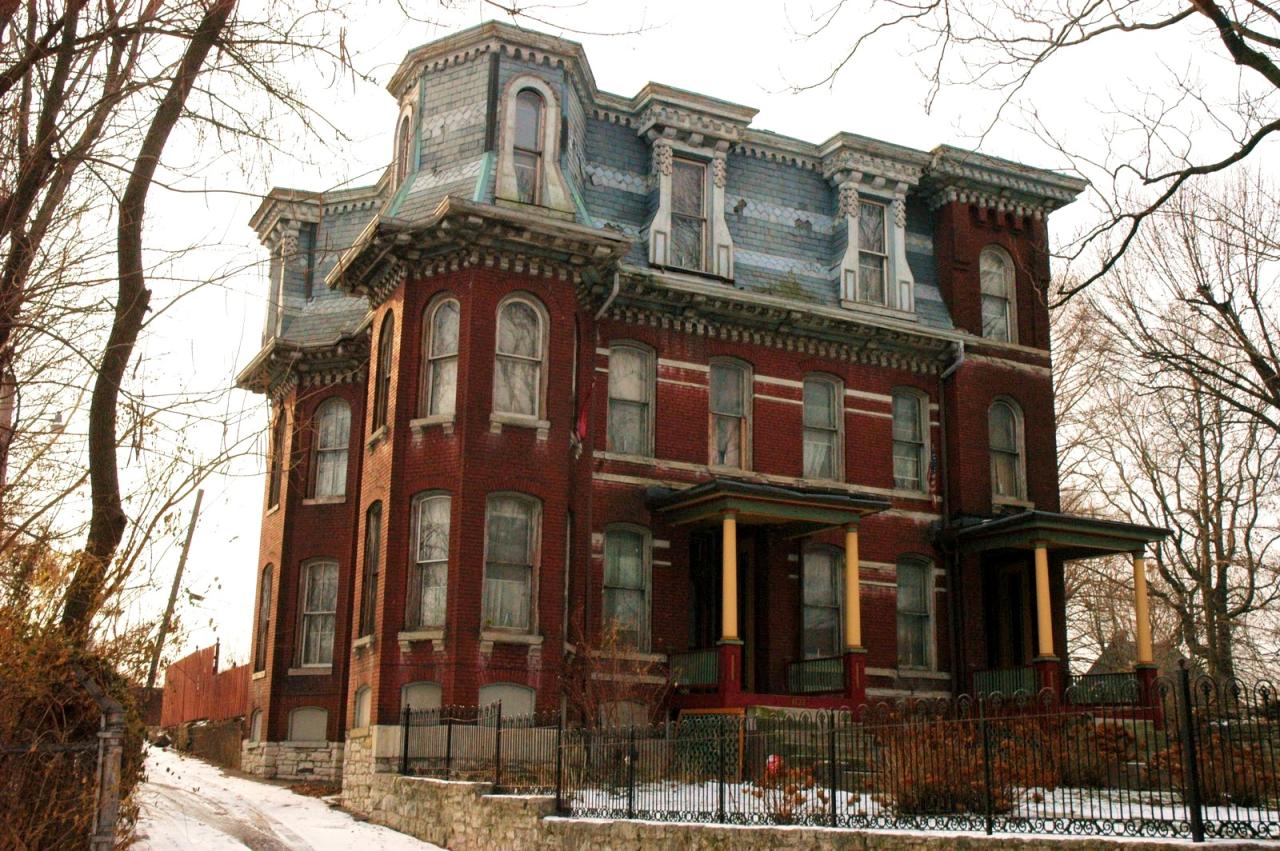
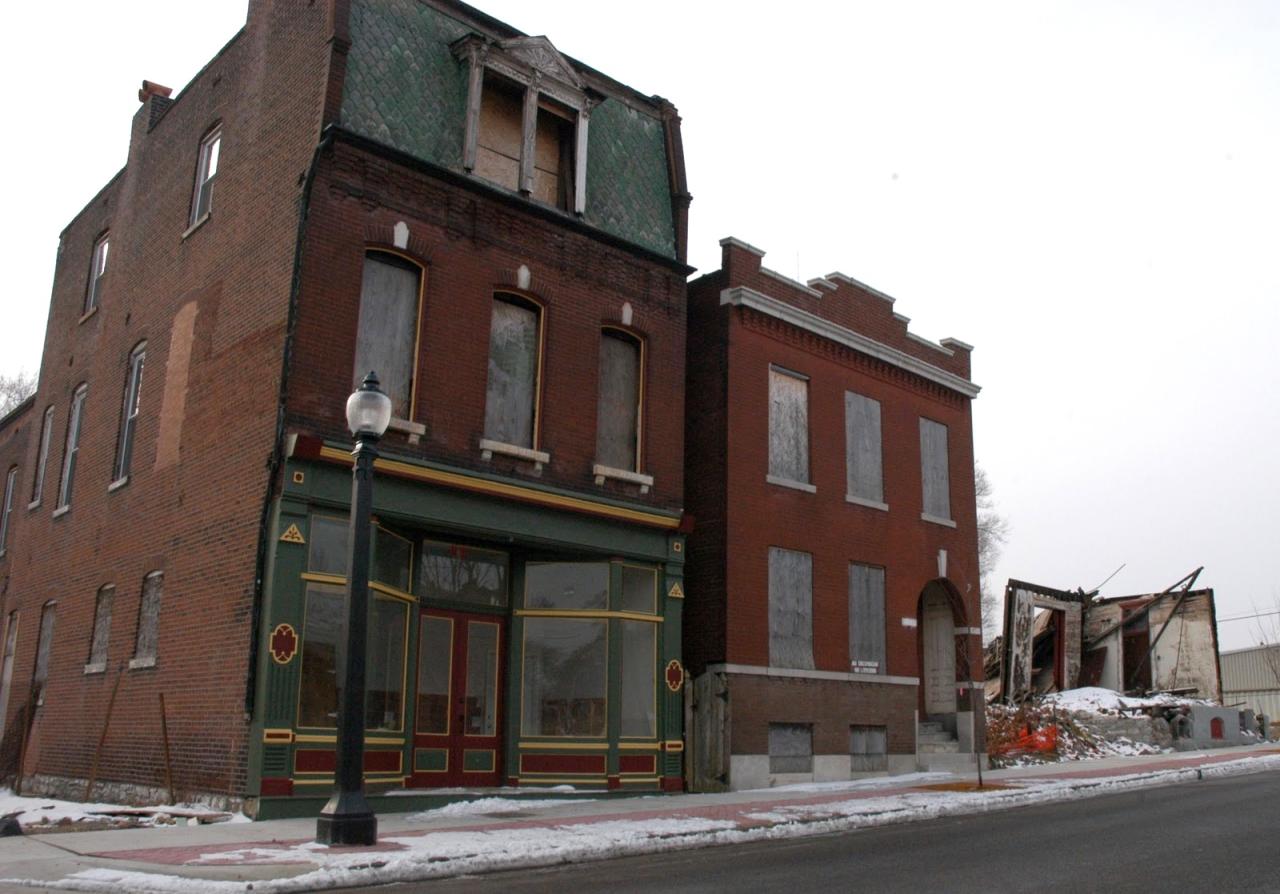
One exciting development are the Irving School Apartments being developed within an old school. They are quite handsome and there was a lot of rehab activity in this particular area of Hyde Park:
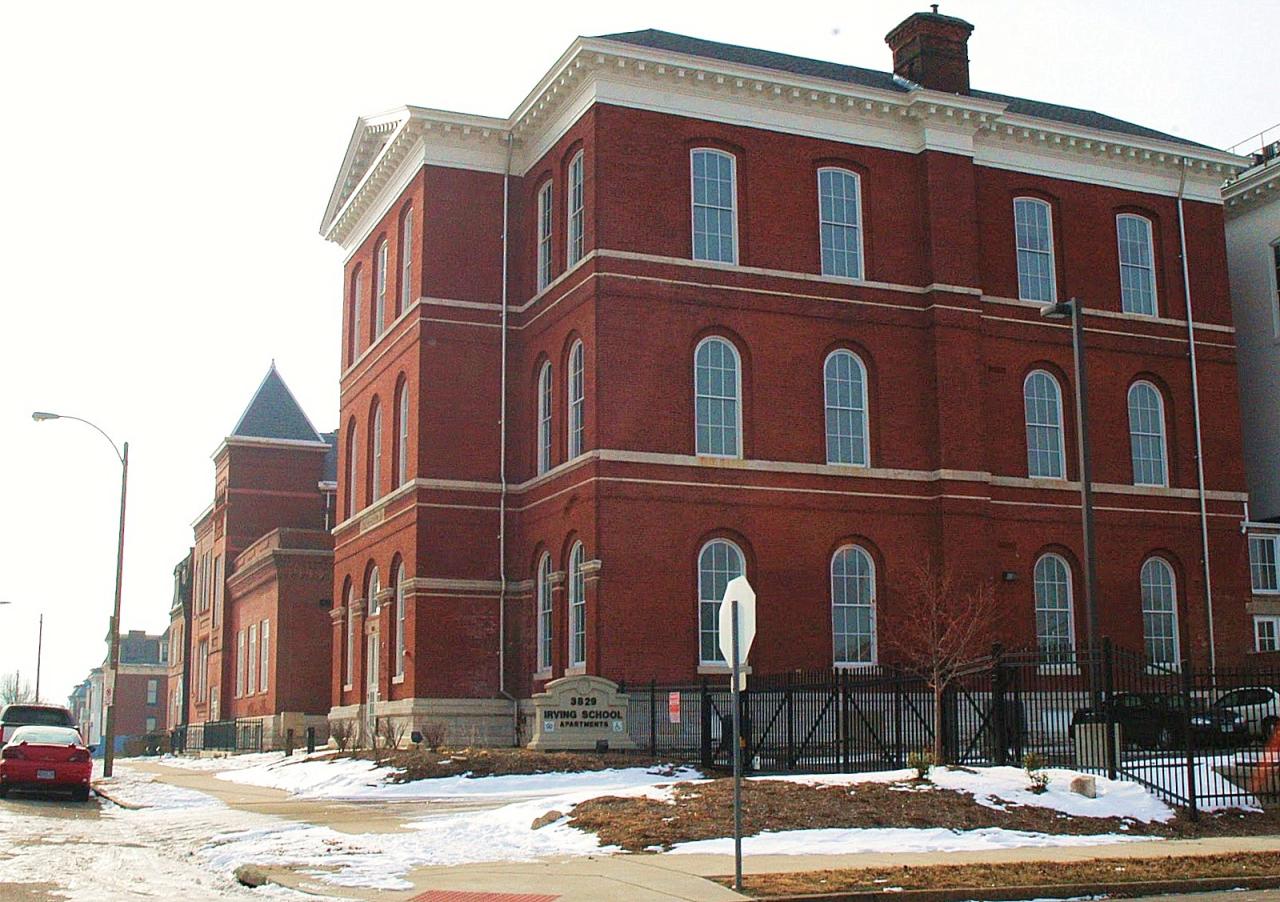
A famed flounder of St. Louis:
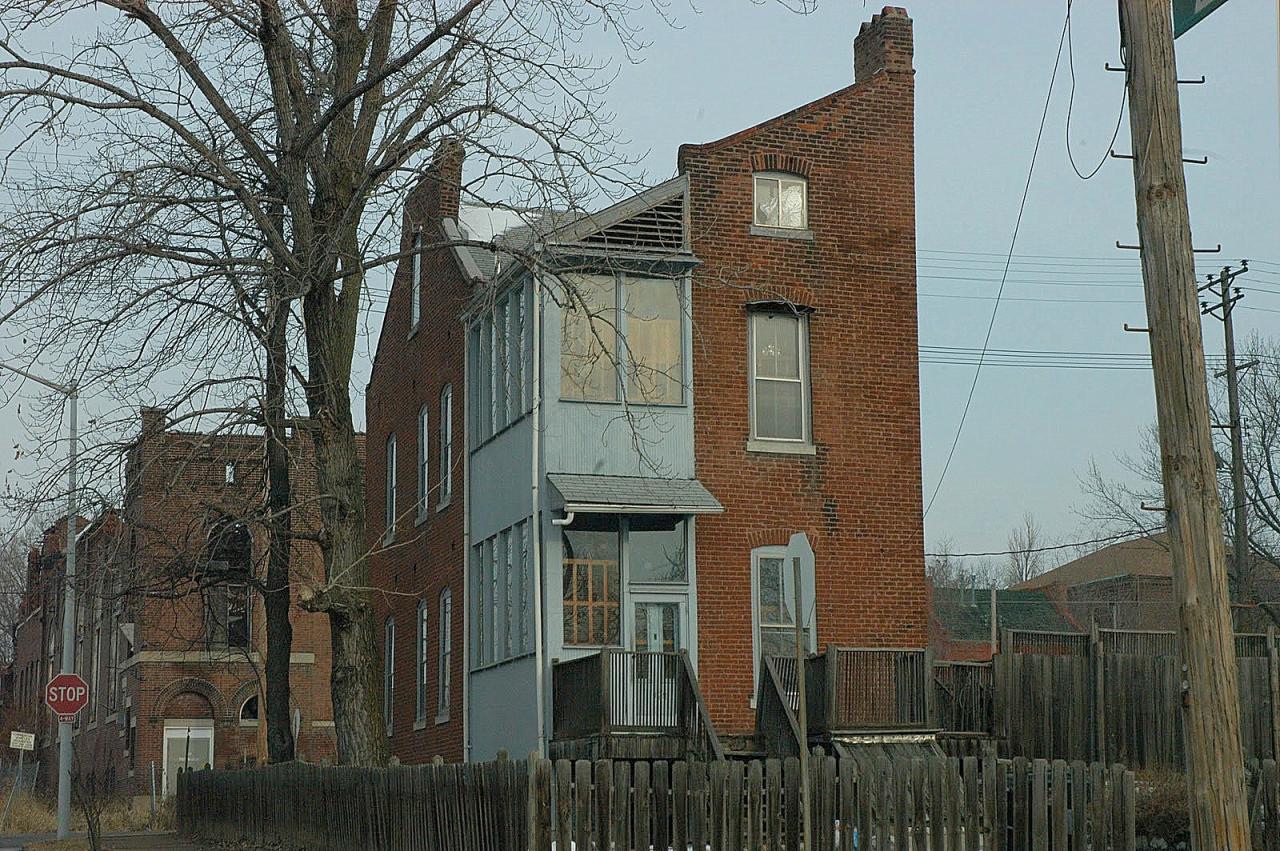
The flounder, sometimes called a half-flounder, is a house type which appears to be unique to St. Louis. The flounder is a narrow house, usually two or two and a half stories tall, and one or two bays wide. Entry was most often from the side elevation, which sometimes had a two-story gallery. Since these houses were exclusively working class homes, decoration was limited, confined to segmental arched windows and perhaps a corbelled cornice. Flounder houses were especially appropriate for dense neighborhoods, where space was at a premium. They were often constructed as alley buildings, sharing a lot with as many as two larger tenement buildings. Flounder houses can be found in the City’s oldest neighborhoods, Old North St. Louis, Hyde Park and Soulard. (from the City of St. Louis website)
Many are boarded up and awaiting rehab:
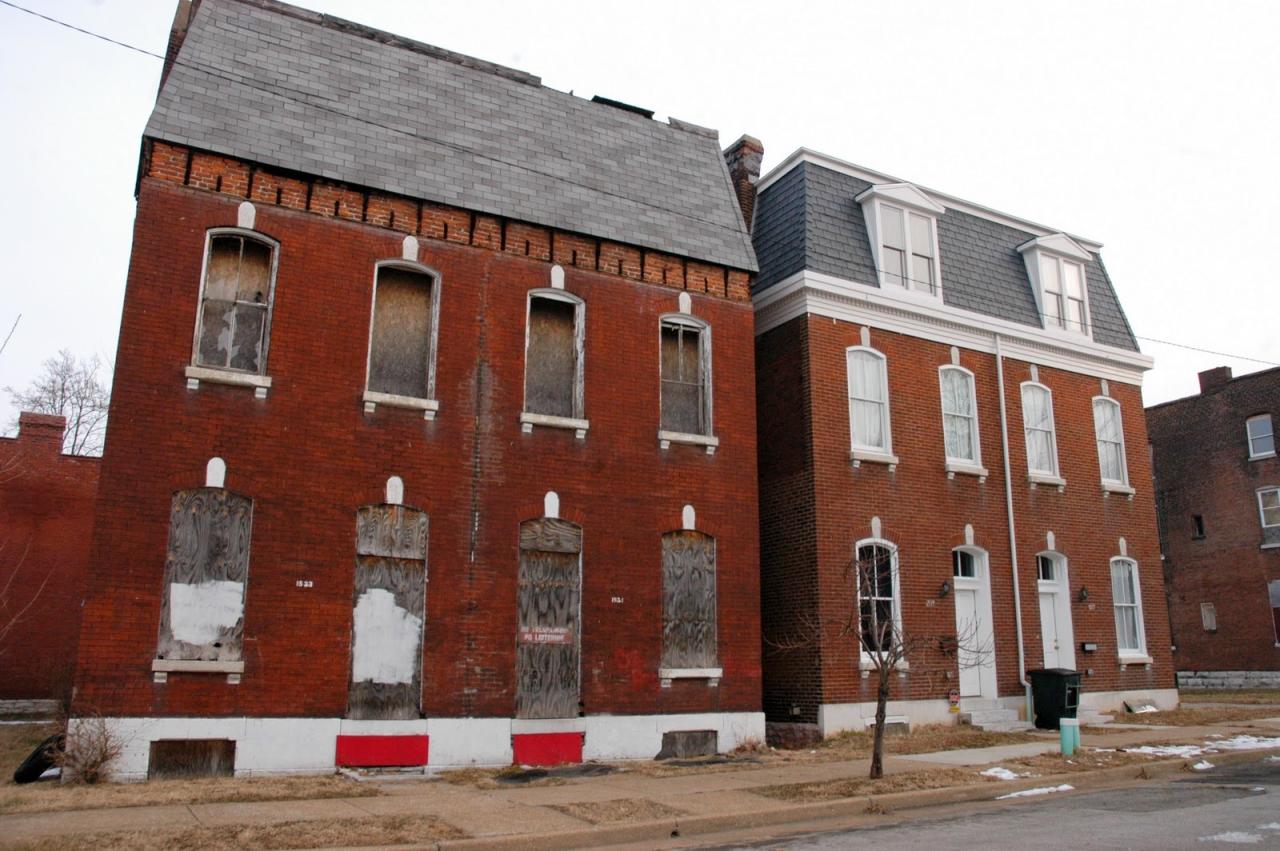
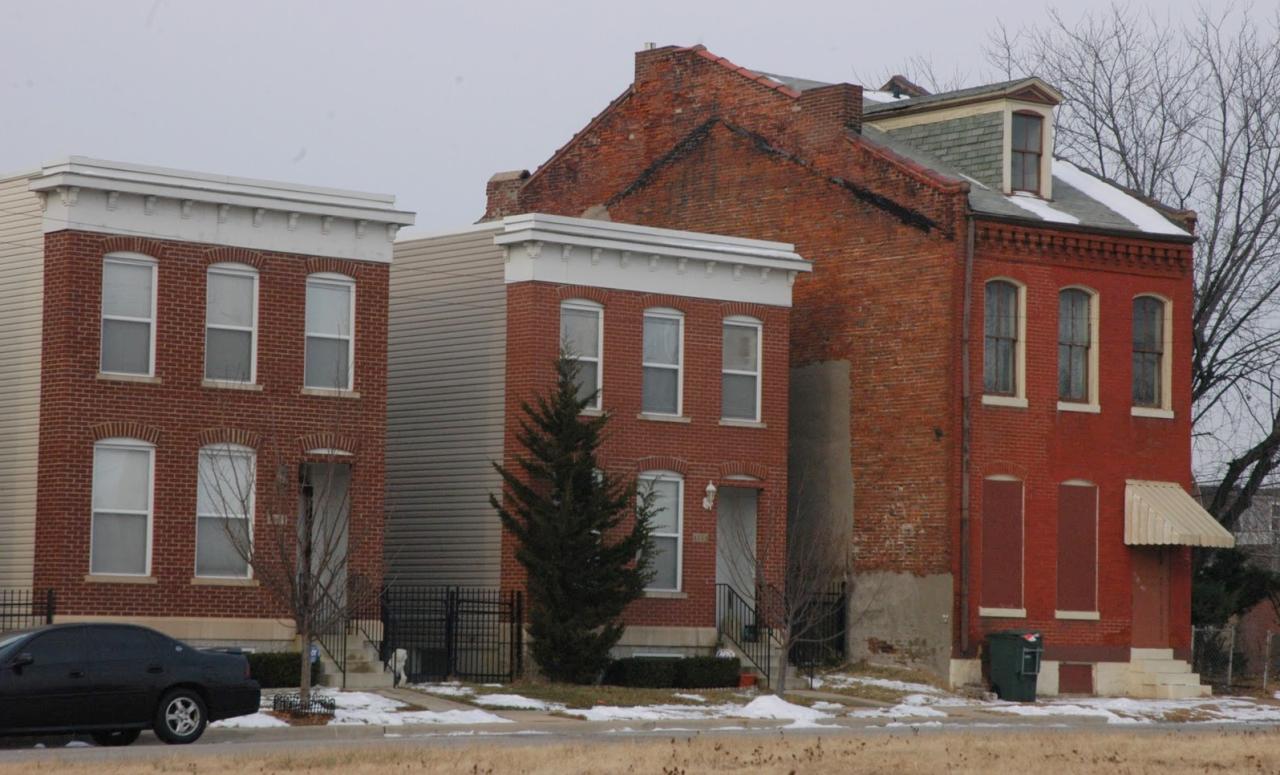
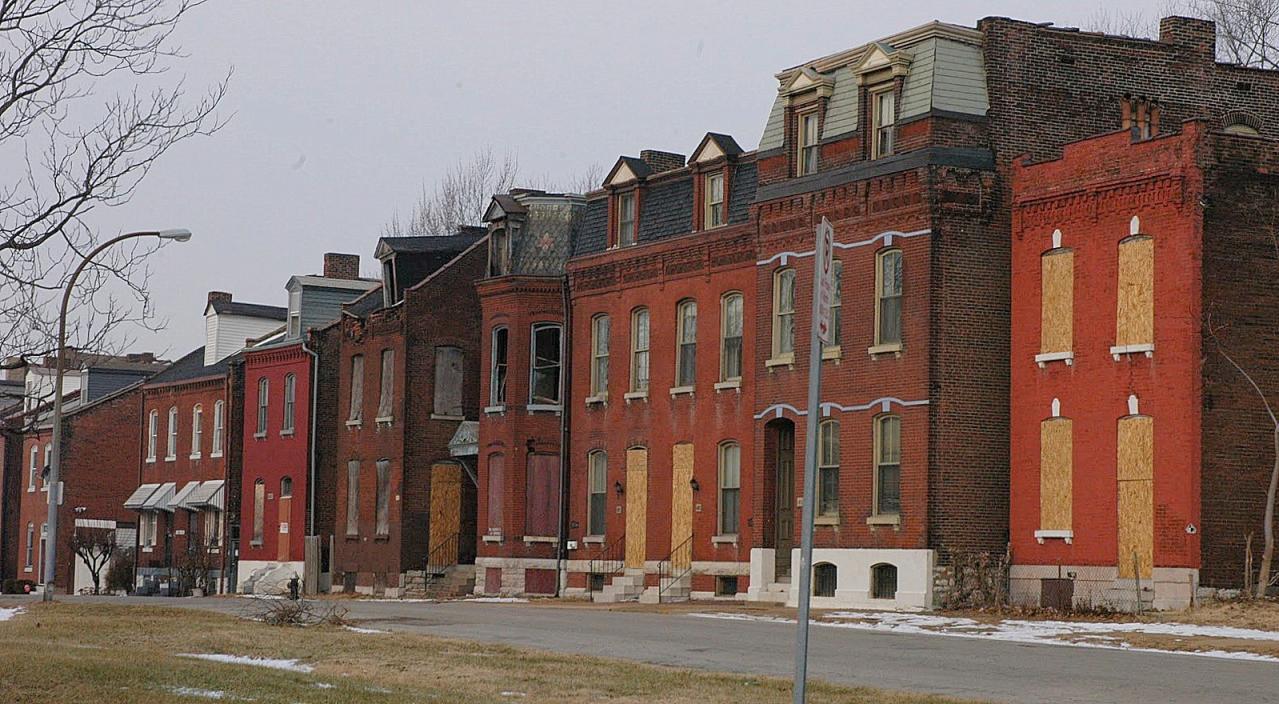
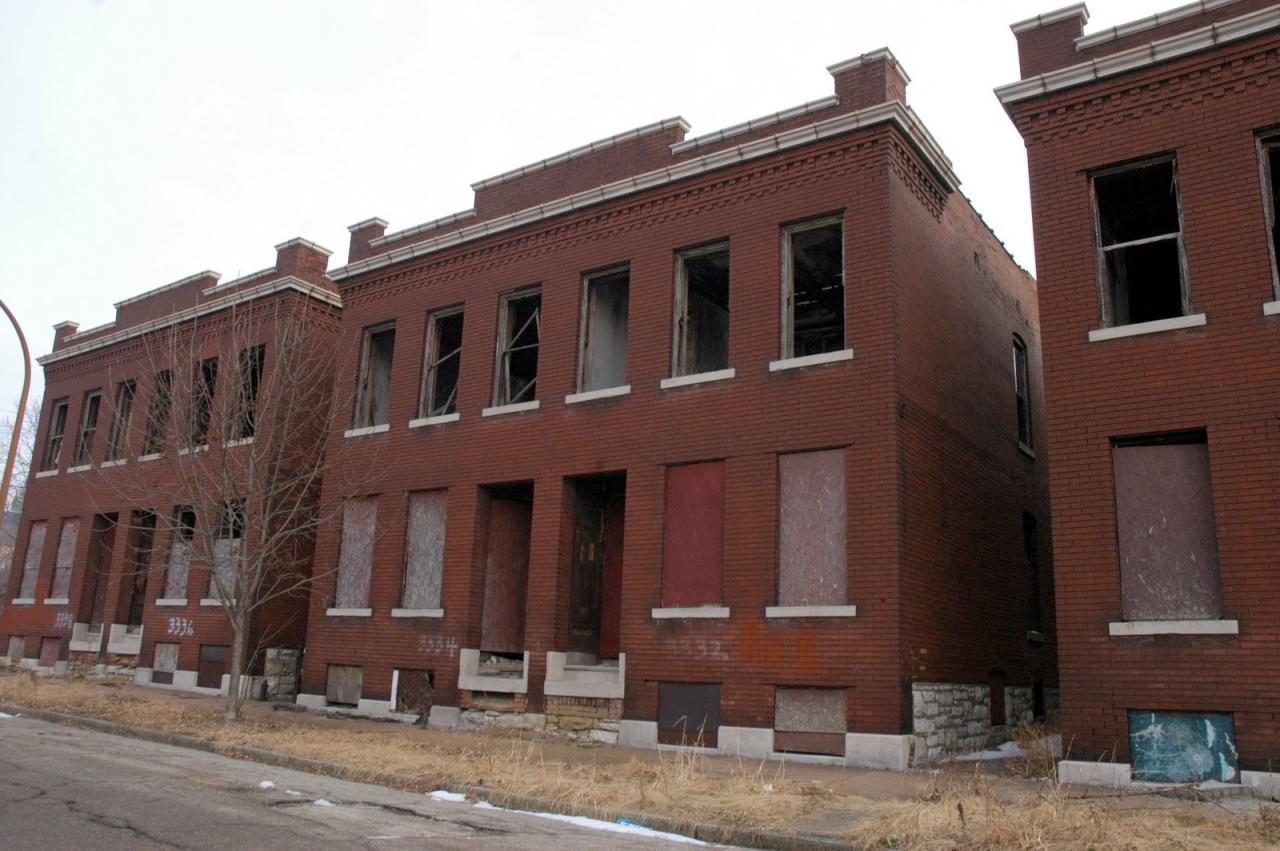
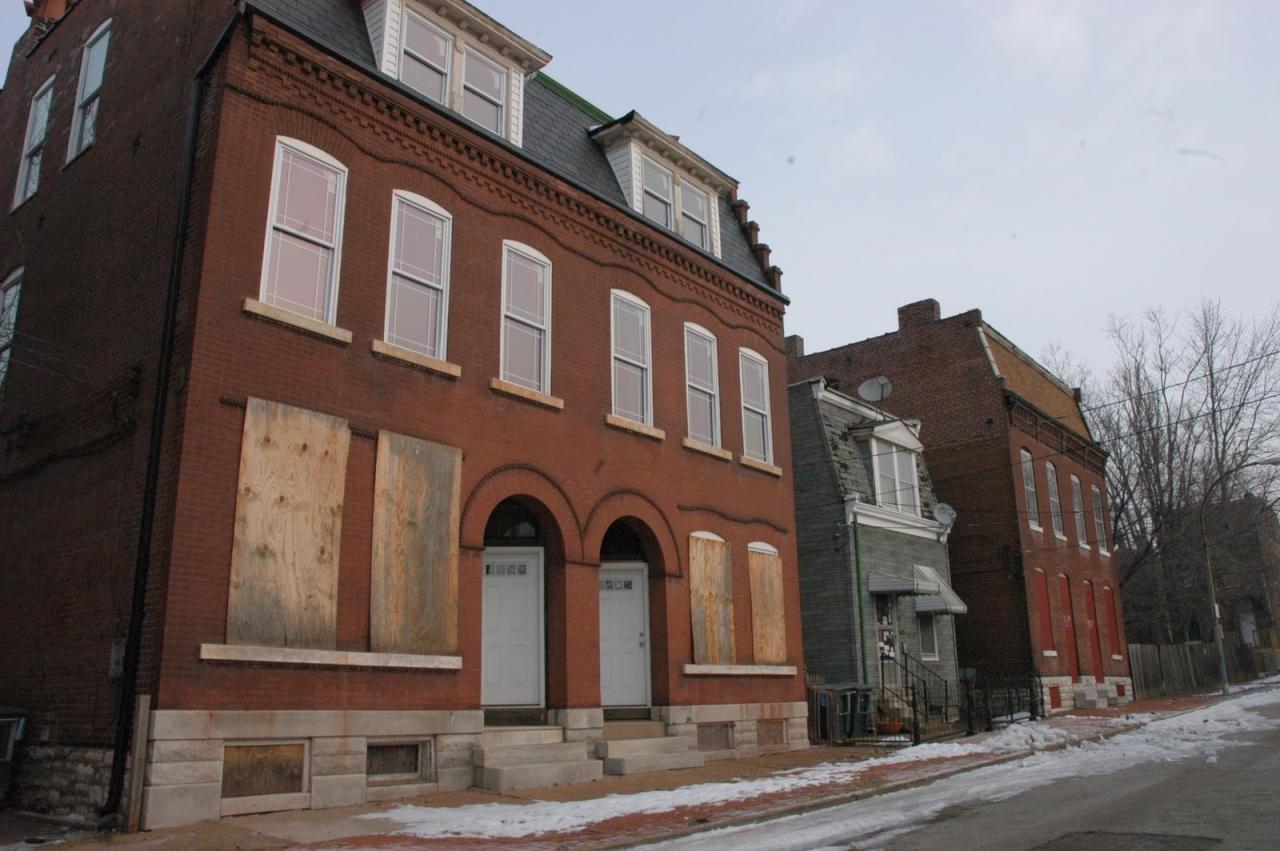
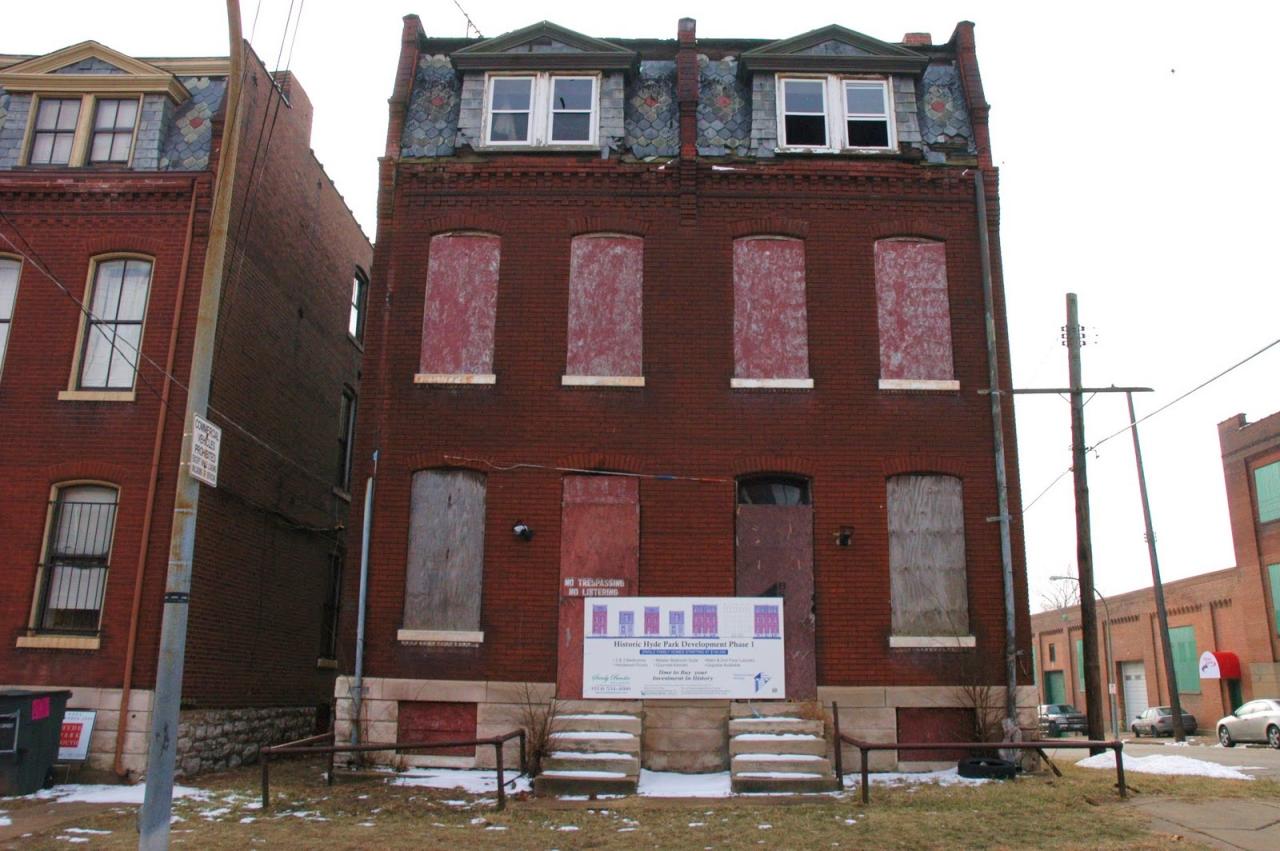
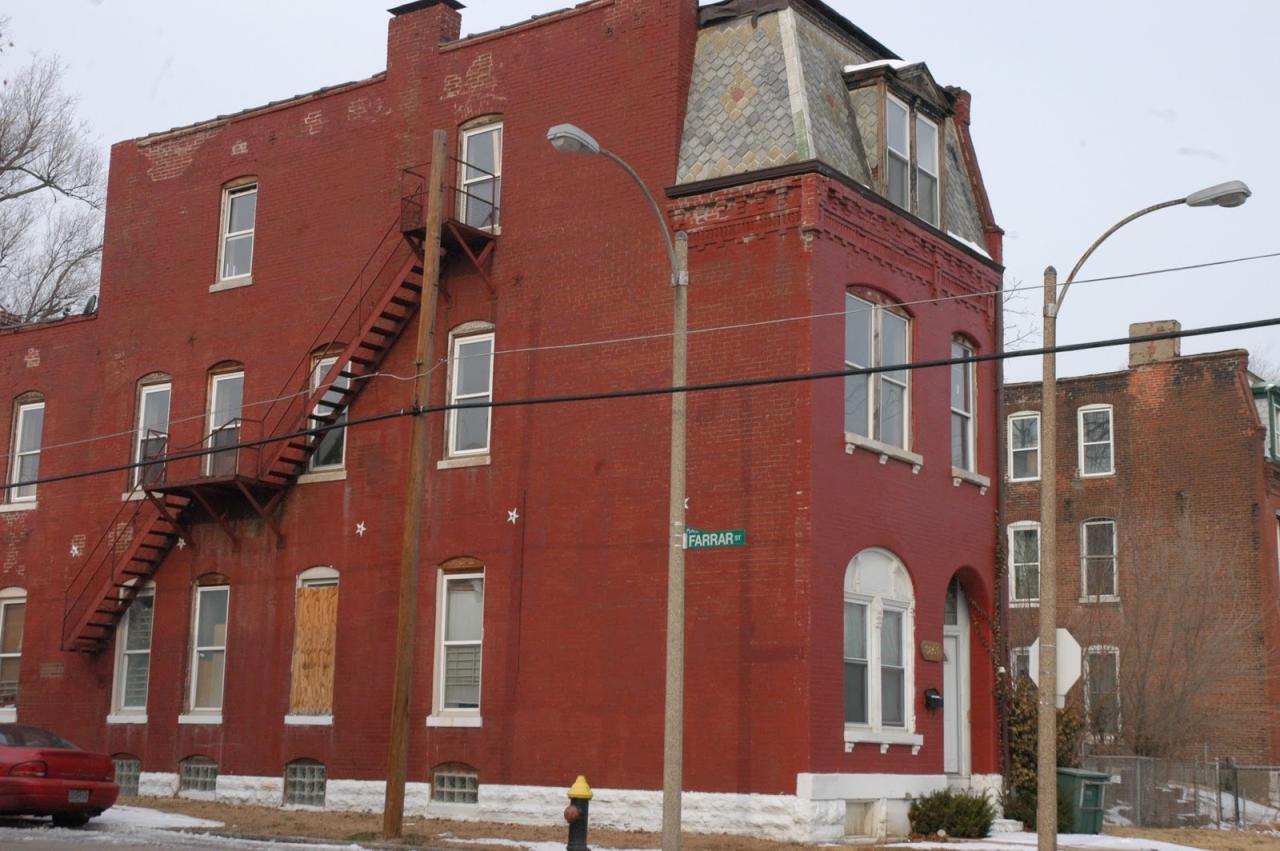
Others are lost or nearly so:
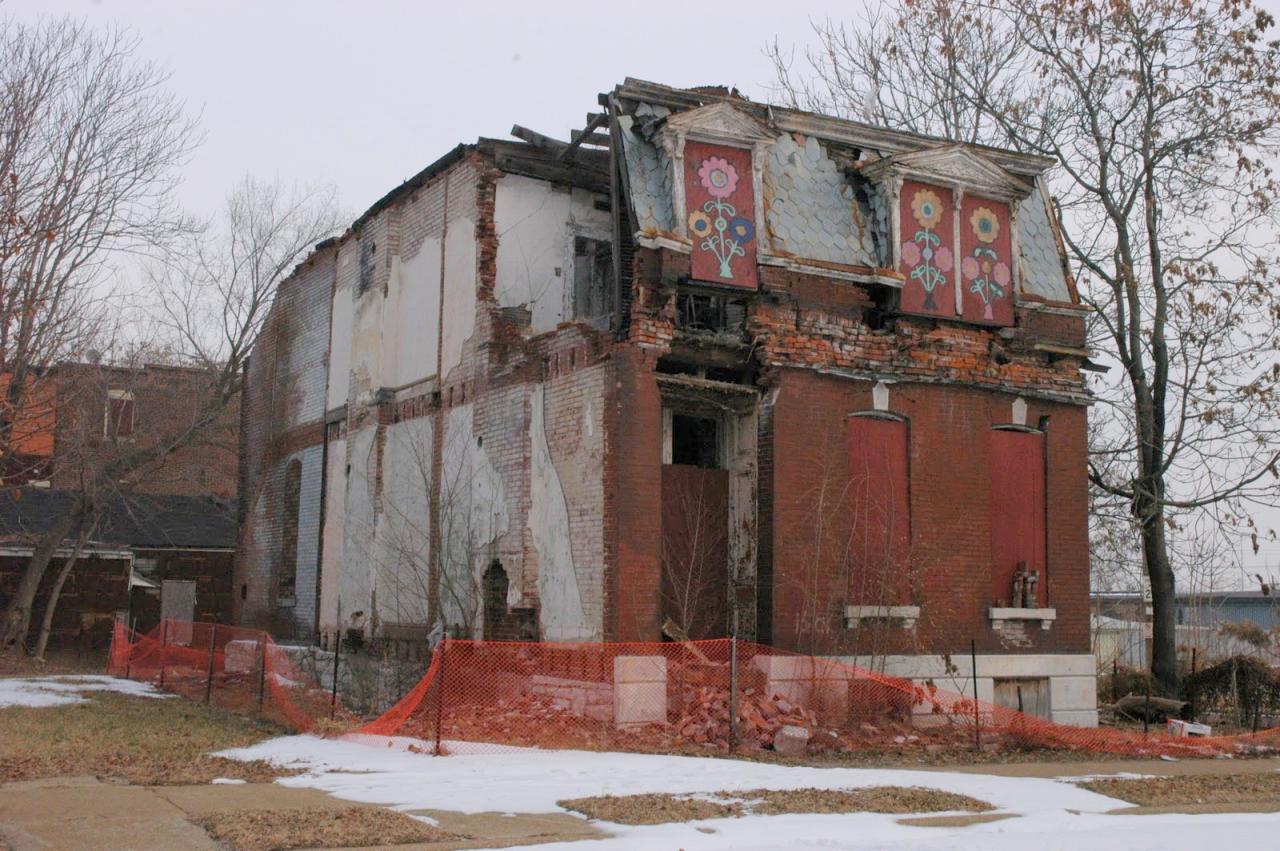
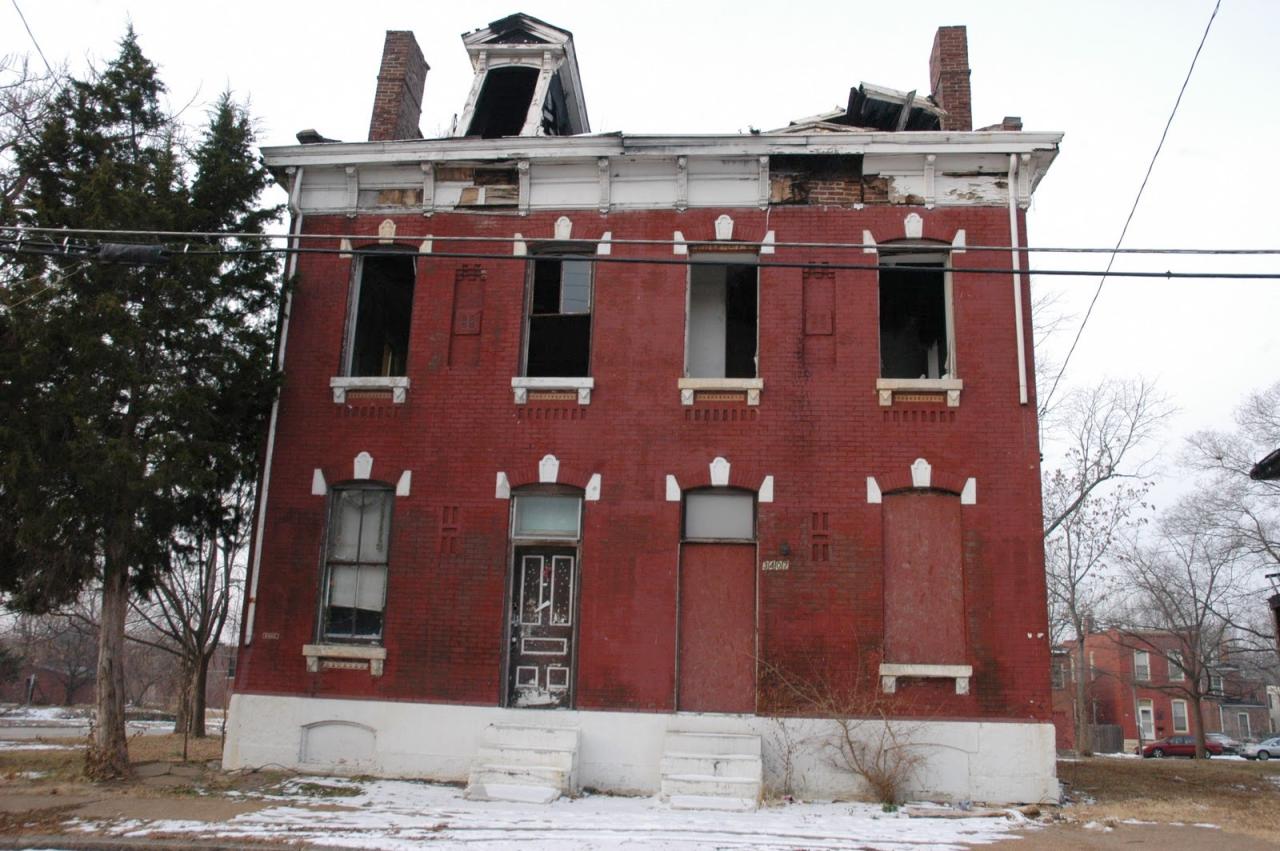
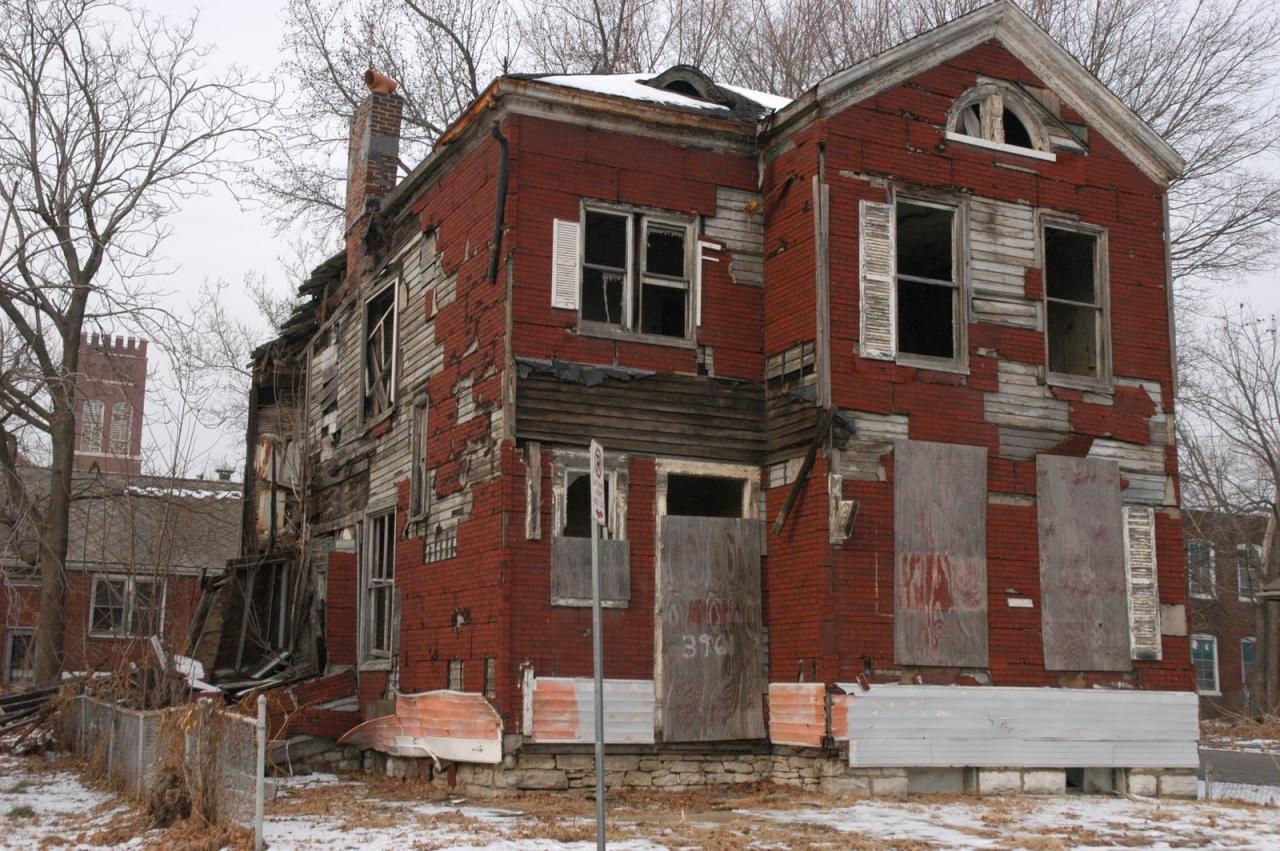
Unfortunately, there are many more examples of the ones above. The simple fact is that for every nicely cared for, occupied home, there is at least a couple board ups or fallen structures either adjacent to or within eye shot. This is pretty much a constant throughout the neighborhood.
Much of the new housing that exists clearly won’t hold up to the test of time as the originals have. This suburban crap makes me irate and is such a quick, short sighted, unsustainable detraction from what could be a neighborhood on the rise:
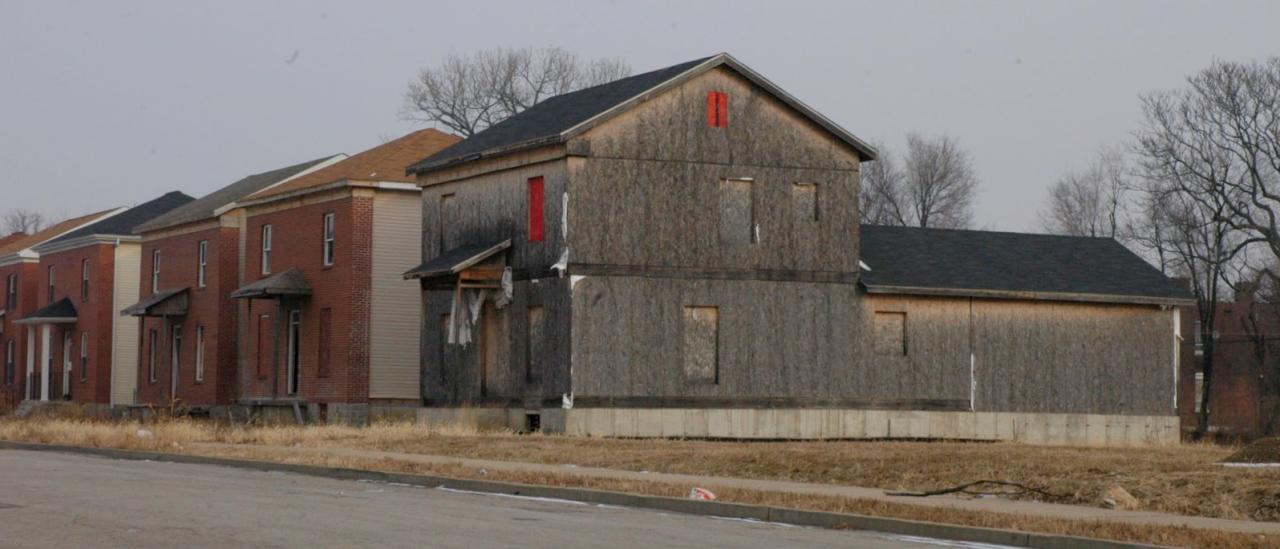
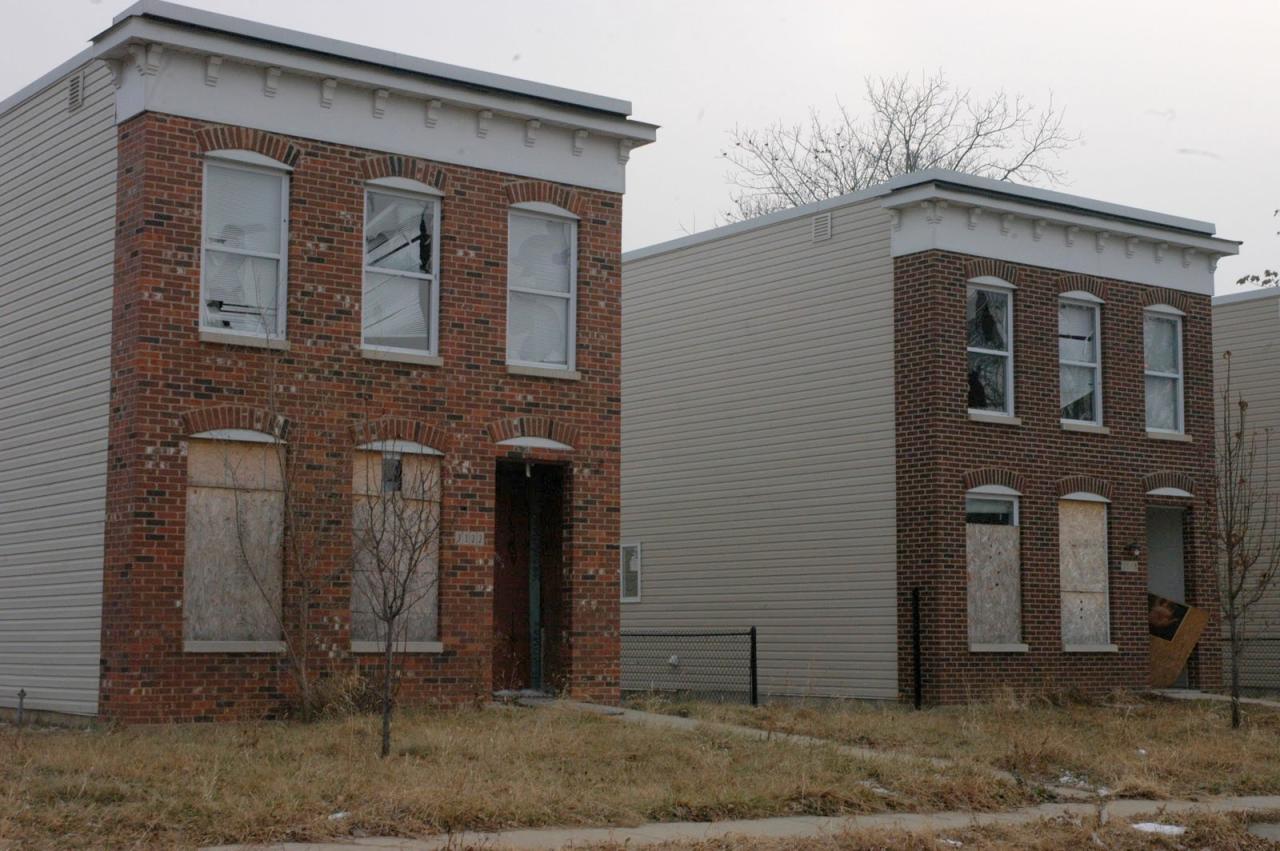
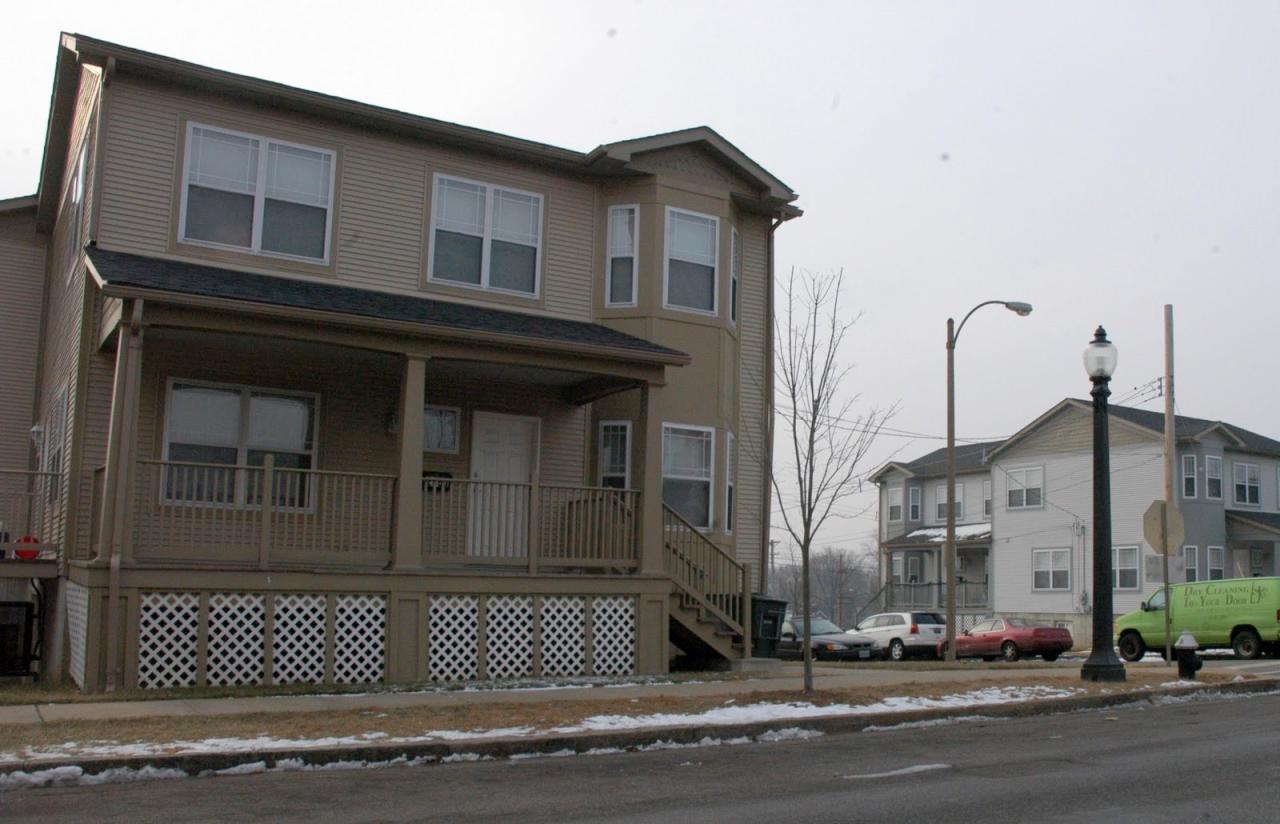
The NorthSide project touches on parts of Hyde Park and here’s some commentary for owner/developer Paul McKee (Thanks McKee, Legacy by McEagle, etc.):
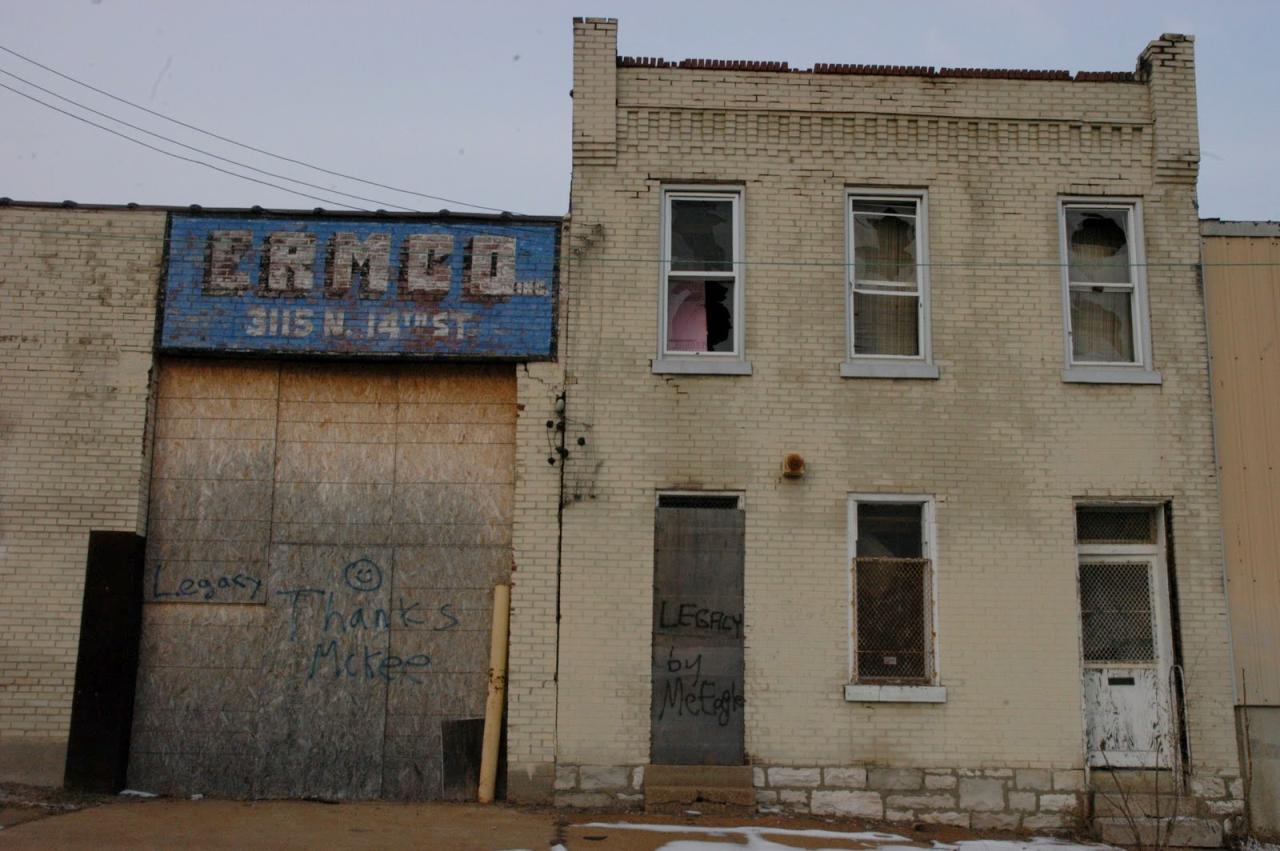
I actually think this criticism is a little misplaced, or at least a little unfair. This guy is just one of many bad landowners that plague this city. You could go on Geo St. Louis, and call out all the shady land and property owners that are hanging on to buildings with no good intent. Why not tag the entire neighborhood calling out all the chumps that have no intent to improve the neighborhood? It’s not just McKee who is the problem, in fact he’s probably the least of our problems. The difference: Paul McKee is actually floating a plan to get infrastructure and development to a part of St. Louis that no one else seems to be able to muster up.
Grand, sweeping change with millions of dollars is necessary if north city will ever make a substantial increase in population, stability and overall safety. The community and aldermen and city for the last 40 years have not been able to send Hyde Park on a positive, upward trajectory. We need sewers, sidewalks, street lights and every other bare minimum that those in the central and south take for granted. McKee needs the benefit of the doubt, but a little social commentary is always called for and a sign that people in the neighborhood are actually informed and care about what’s going on in their neck of the woods. Although, I doubt if the anti-McKee tagging that has taken place was the action of the politically aware and dismayed people living in these or other north side neighborhoods.
All right, enough of my rant.
There are other stately buildings worth noting including the beautiful Most Holy Trinity Catholic church and school on Mallinkrodt with it’s twin spires visible from I-70. This appears to be an anchor of sorts in the community and the are immediately surrounding the church is simply beautiful:
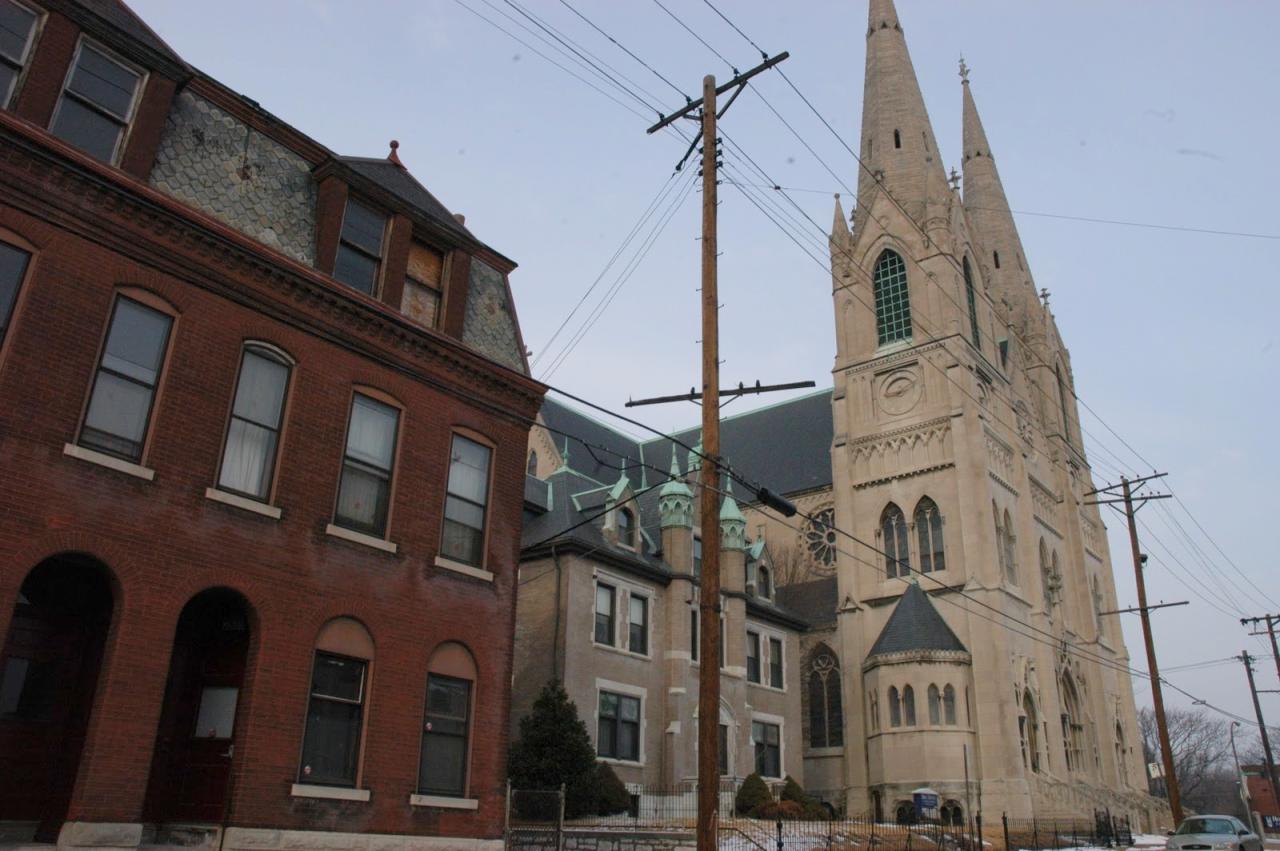
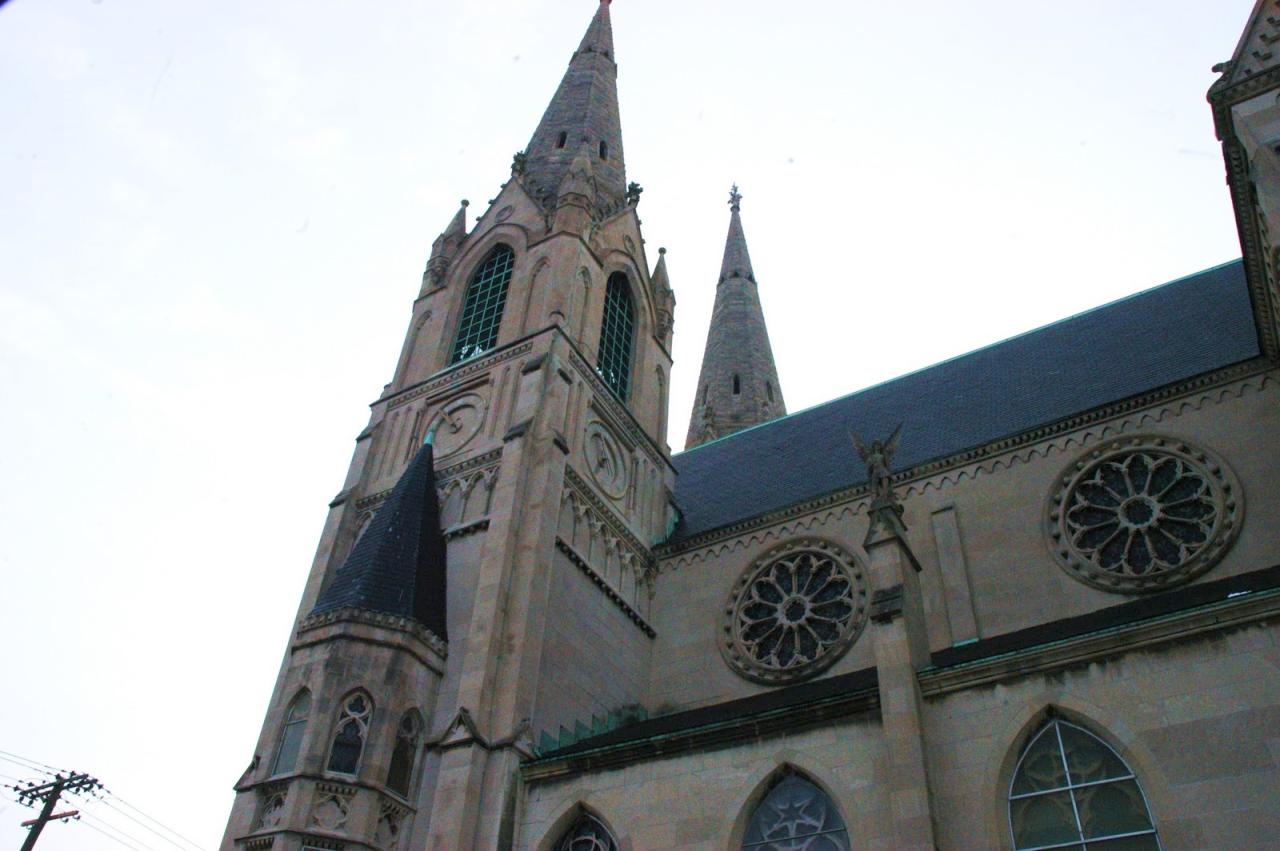
The firehouse that sits on the edge of Hyde Park is a classic:
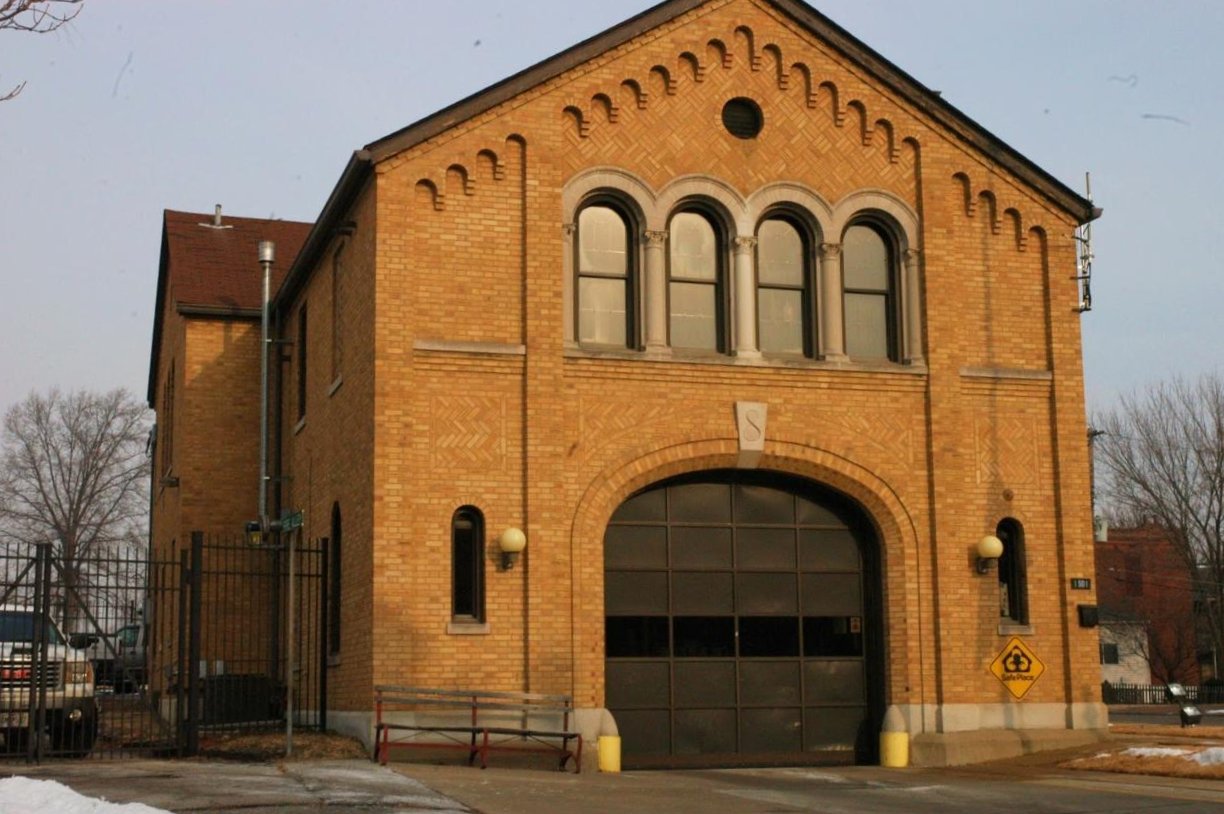
Other faiths constructed nice churches as well:
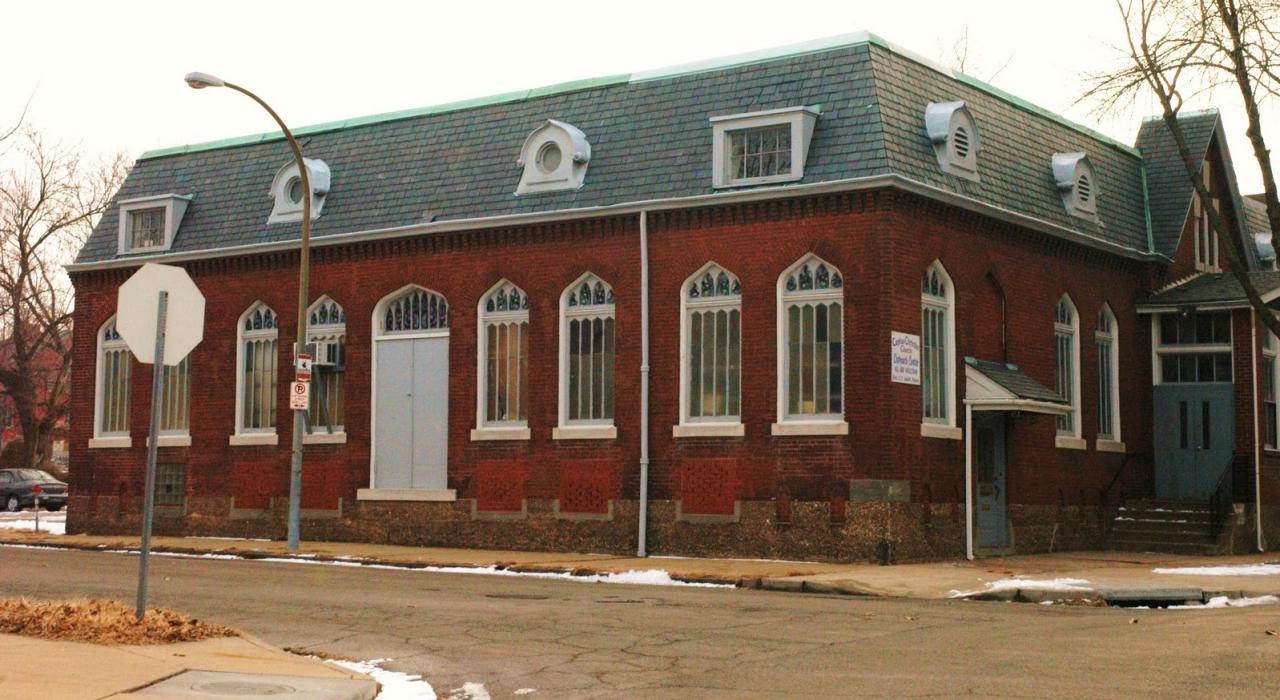
There are some impressive schools/SLPS admin buildings as well (from the City of St. Louis website):
Oldest of the public schools in the Hyde Park area is the Henry Clay School, now located at 3820 North Fourteenth Street. Originally it was started in a three story brick building at the southwest corner of Bellefontaine Road (Eleventh Street) and Farrar Street in 1859. This school contained twelve rooms with a capacity of 940 students. The present Clay School, designed by William B. Ittner on a large H-shaped academic plan, was completed in 1905. The Library Service Center of the Board of Education is now on the site of the old Clay School. The Center was designed by Mariner and LaBeaume in 1909 as the Divoll Branch of the Public Library and was so used until about 1965. It was pilastered brick walls on a granite foundation with a richly developed stone trim.
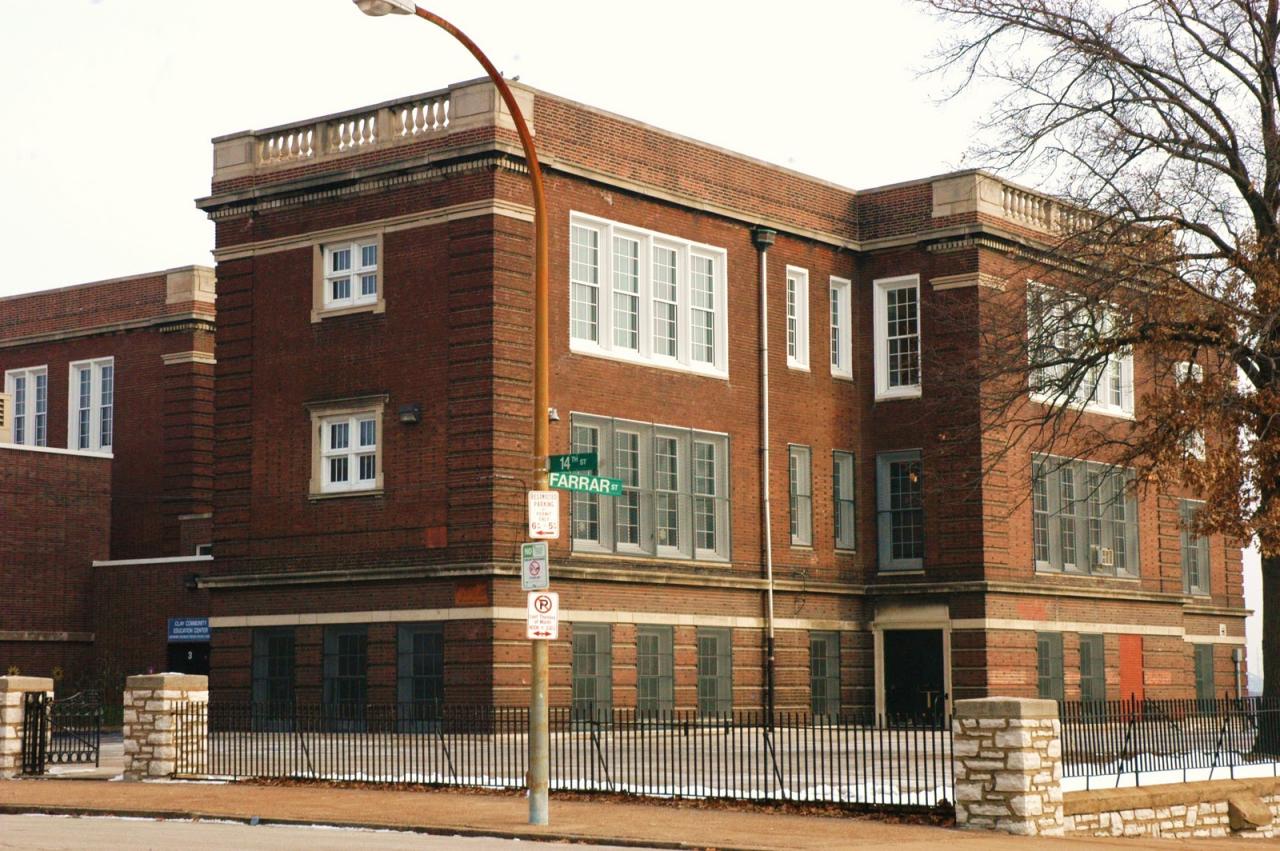

Hyde Park is a classic example of St. Louis beauty and neglect. If I were in charge or had any kind of say, $ or power…this would be top 5 priority for the city to turn this neighborhood around and get more people living here. I imagine and day dream about an active and thriving community as I drive through it today. However, I don’t think I’ll see that in my lifetime.

 Hyde Park is a north St. Louis neighborhood roughly bound by Ferry Street to the north, I-70 to the east, Natural Bridge Avenue/Palm Street to the south and Glasgow Avenue to the west.
Hyde Park is a north St. Louis neighborhood roughly bound by Ferry Street to the north, I-70 to the east, Natural Bridge Avenue/Palm Street to the south and Glasgow Avenue to the west.
